Banff Springs GC Hole-by-Hole
Stanley Thompson is unquestionably Canada’s most revered golf architect. He is to Canada what Old Tom Morris is to Scotland and Donald Ross to United States, and strangely enough both of them have a connection to Banff. Among the 175 or so courses Thompson is credited with nine are in Canadian National Parks of which eight are still in operation – the Elk Island nine recently closed and its future is uncertain. At least four of the eight courses are considered masterpieces and all of these are rated in the SCORE Golf Top 100; Jasper Park Lodge is currently #4, Highlands Links #12 and Waskesiu in Prince Albert NP #47. Banff Springs currently clocks in at #9 and as you might agree after reading this post, it could be ranked even higher.
History of Banff Springs
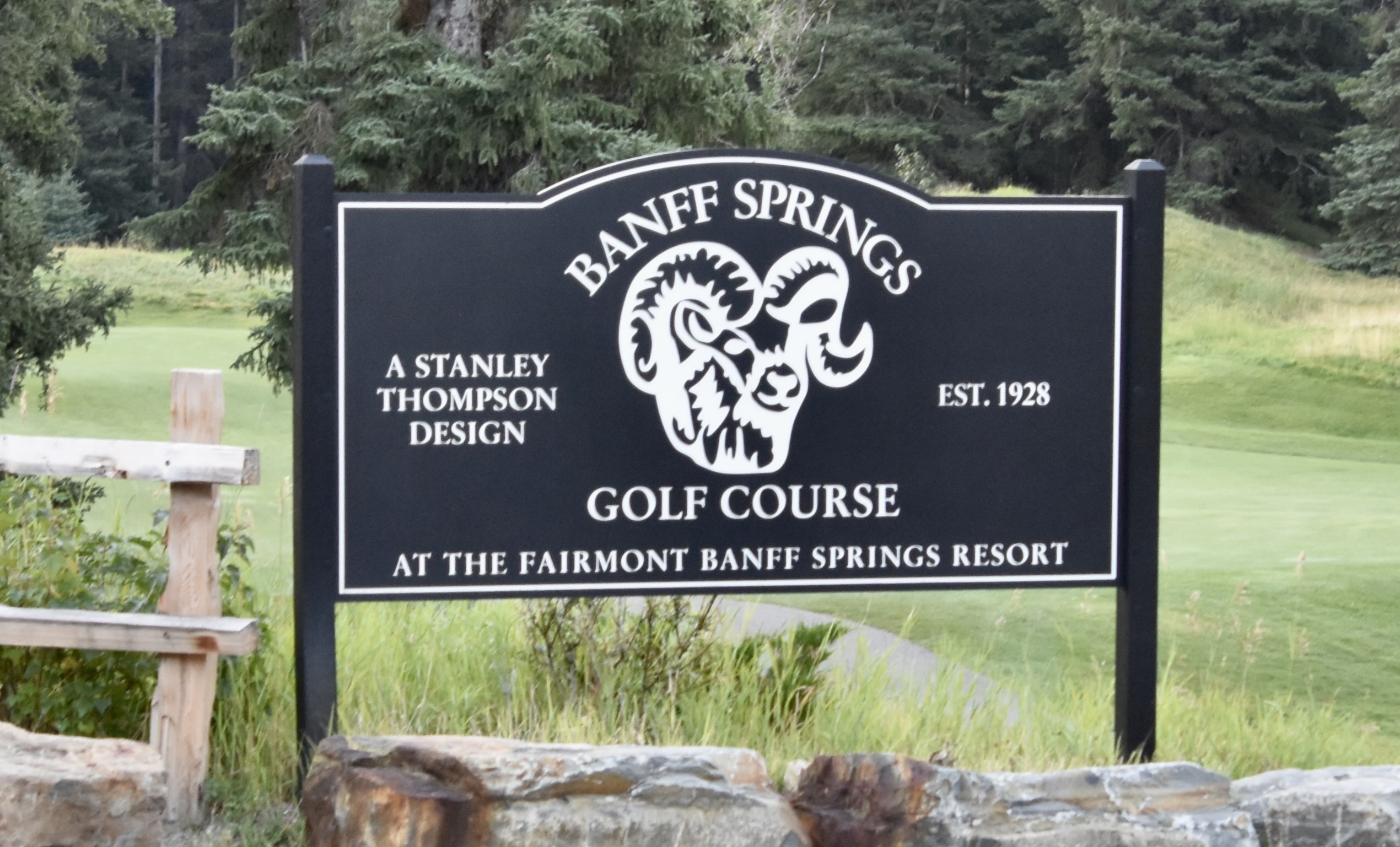
Banff is the oldest national park in Canada; founded in 1885 it is the third oldest national park in the world after Yellowstone and Royal NP in Australia. The beauty of the Canadian Rockies has attracted tourists from the day the park opened which also coincided with the completion of the transcontinental railway in the same year. In 1888 the majestic Banff Springs Hotel opened, completely transforming the town, originally known as just Siding 29, into a worldwide tourism destination. Today Banff is part of the Canadian Rockies UNESCO World Heritage Site, one of the largest in the world.
The tourism boom brought about by the expansion of the railway networks in North America, also coincided with the explosion of golf on the scene with Royal Montreal being the first in Canada in 1879 followed by a plethora of others almost every year thereafter. The first version of Banff Springs GC, a nine hole layout designed by Bill Thomson, a Scottish acolyte of Old Tom Morris, opened in 1911. In 1924 Donald Ross was brought in to expand the course to 18 holes. A year later Stanley Thompson’s Jasper Park Lodge course, commissioned by the Canadian National Railway, opened and was immediately deemed a must play course. Not to be outdone Canadian Pacific then commissioned Thompson to create today’s version of the Banff Springs course, although there are still some elements of the Donald Ross course incorporated in it. By the time the new Banff Springs opened in 1928 it was the most expensive golf course ever built at that time.
And it worked out just as the CPR had hoped. Golfers from around the world flocked to play this course that many consider to be the best mountain course in the world. Holes #4 and #15 are included in Jeff Barr’s 1001 Golf Holes You Must Play Before You Die.
So with that background let’s visit the course.

The Pro Shop is not as voluminous as some of the resort courses Alison and I have played, but it is well stocked, particularly with souvenir items of the course. You will almost certainly want to buy some reminder that you got to play this iconic course.
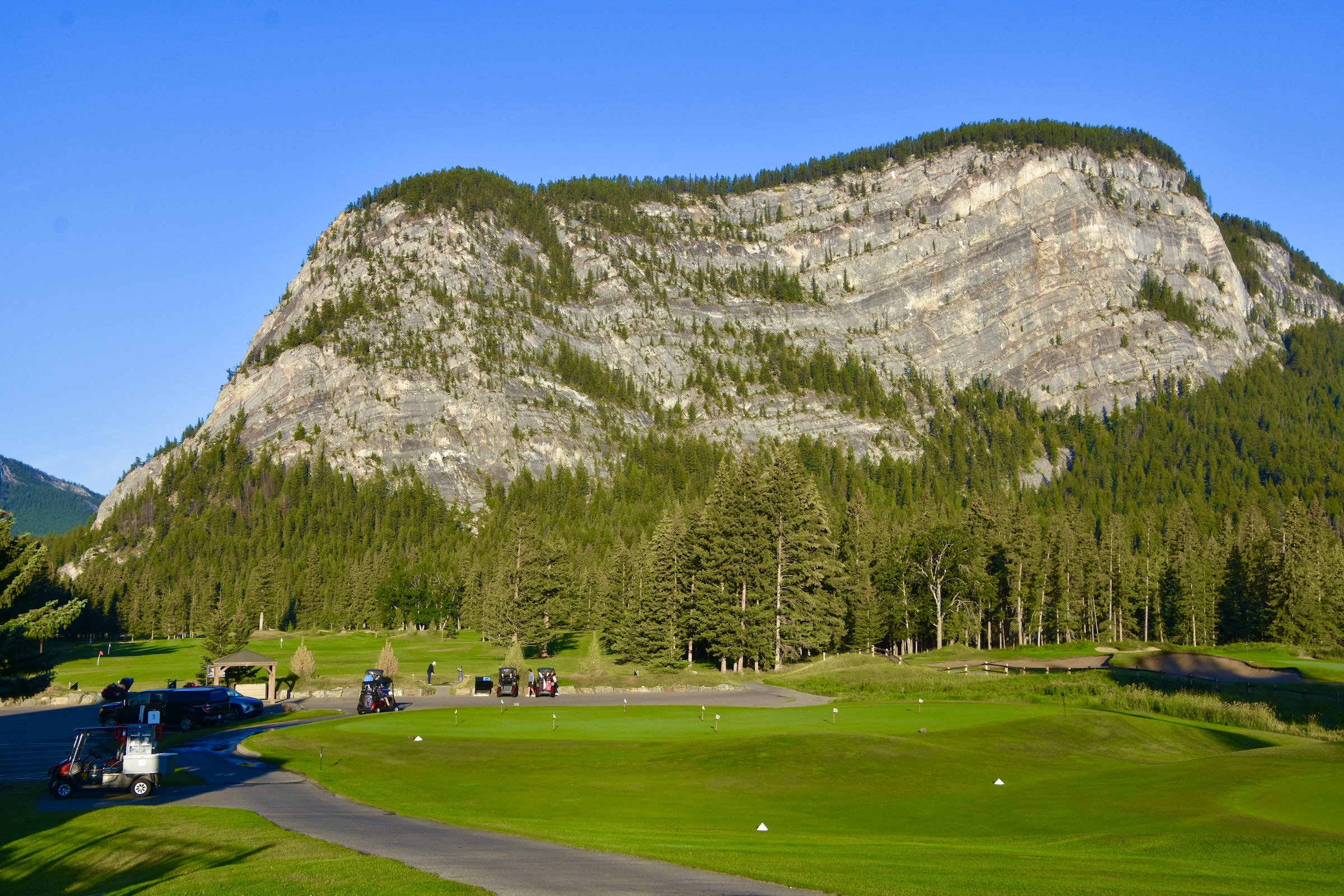
The Banff Springs practice facility is excellent, but you can easily get distracted by the beautiful mountain views.
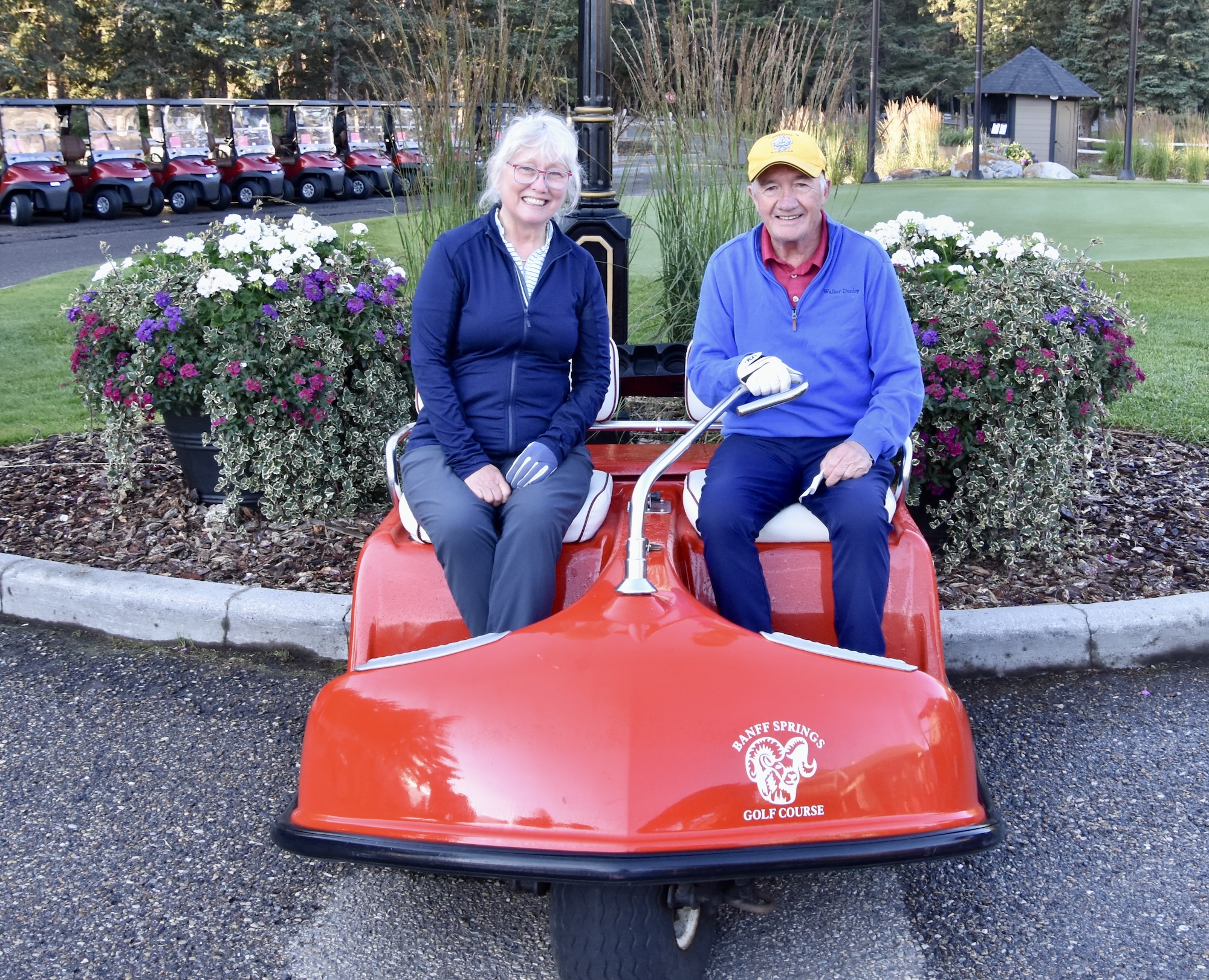
Before picking up our state of the art golf cart, we pose for this photo in one of the vintage carts that once were the cat’s meow of the golf world when they first came out. The idea of driving instead of walking first appeared in the 1950s and at first was only embraced by those who had difficulty walking a course. However, by the 1960s it was deemed acceptable to ride without being considered a lazy slob.
Carts are included with the green fees at Banff Springs, but walking is quite acceptable. What is surprising about this course is that despite being in the mountains, it is relatively flat. There is one serious climb on #15 to a high tee box, but other than that it’s very walkable.
As noted the carts at Banff Springs are state of the art with GPS and bluetooth both enabled. This is an example of the display the cart will provide. You can point to any place on the map and the distance to that point will appear. That’s extremely helpful on a course you are playing for the first time.

I did not know that there is a second nine hole course at Banff Springs. The Tunnel course, a Cornish & Robinson design, opened in 1989. Geoffrey Cornish was an understudy of Stanley Thompson and thus an appropriate choice to complement the work of the master.
So, the hole-by-hole in this post is on the Stanley Thompson 18. Let’s get to it.
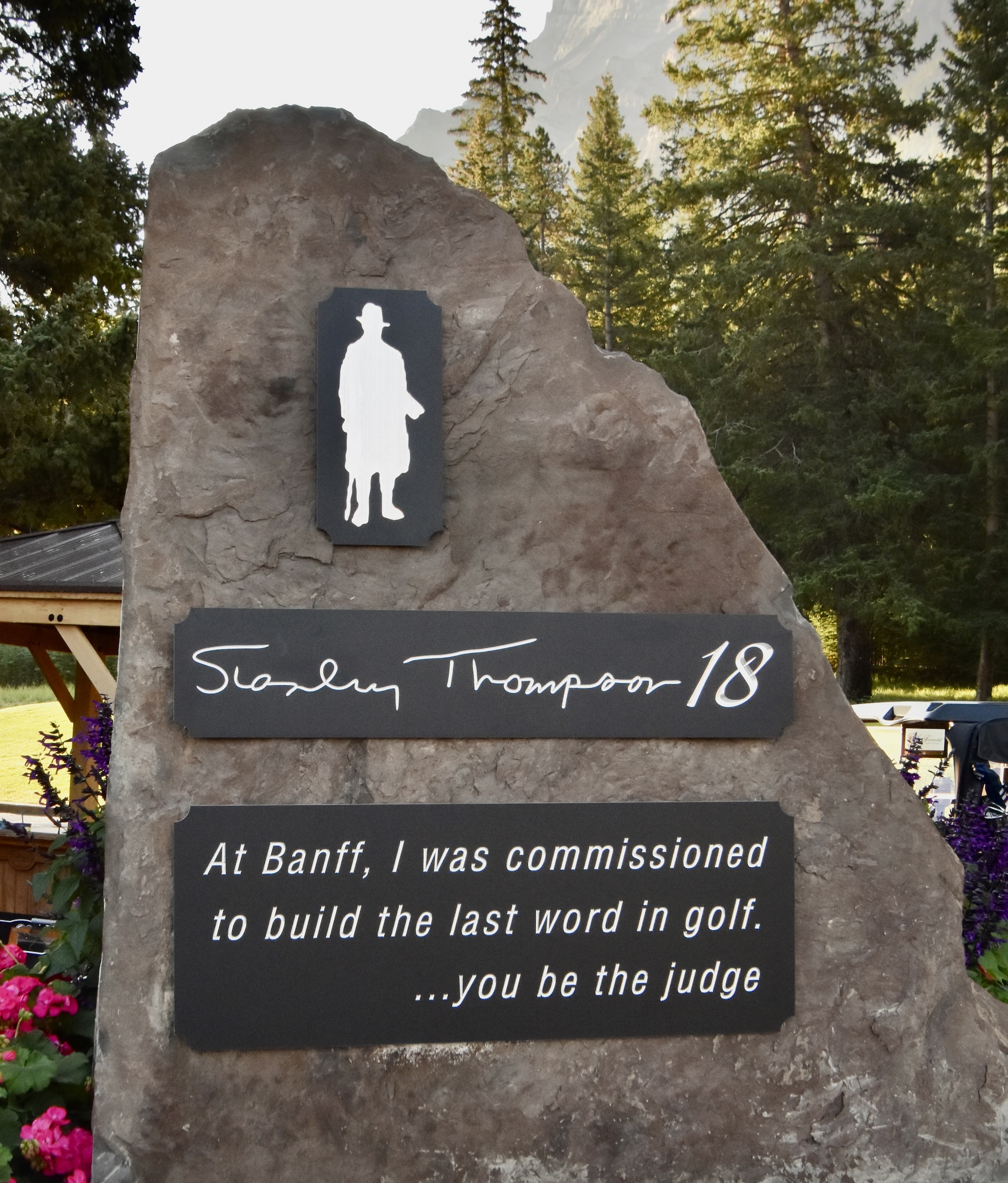
Banff Springs No. 1 Peechee – 383 Yard Par Four
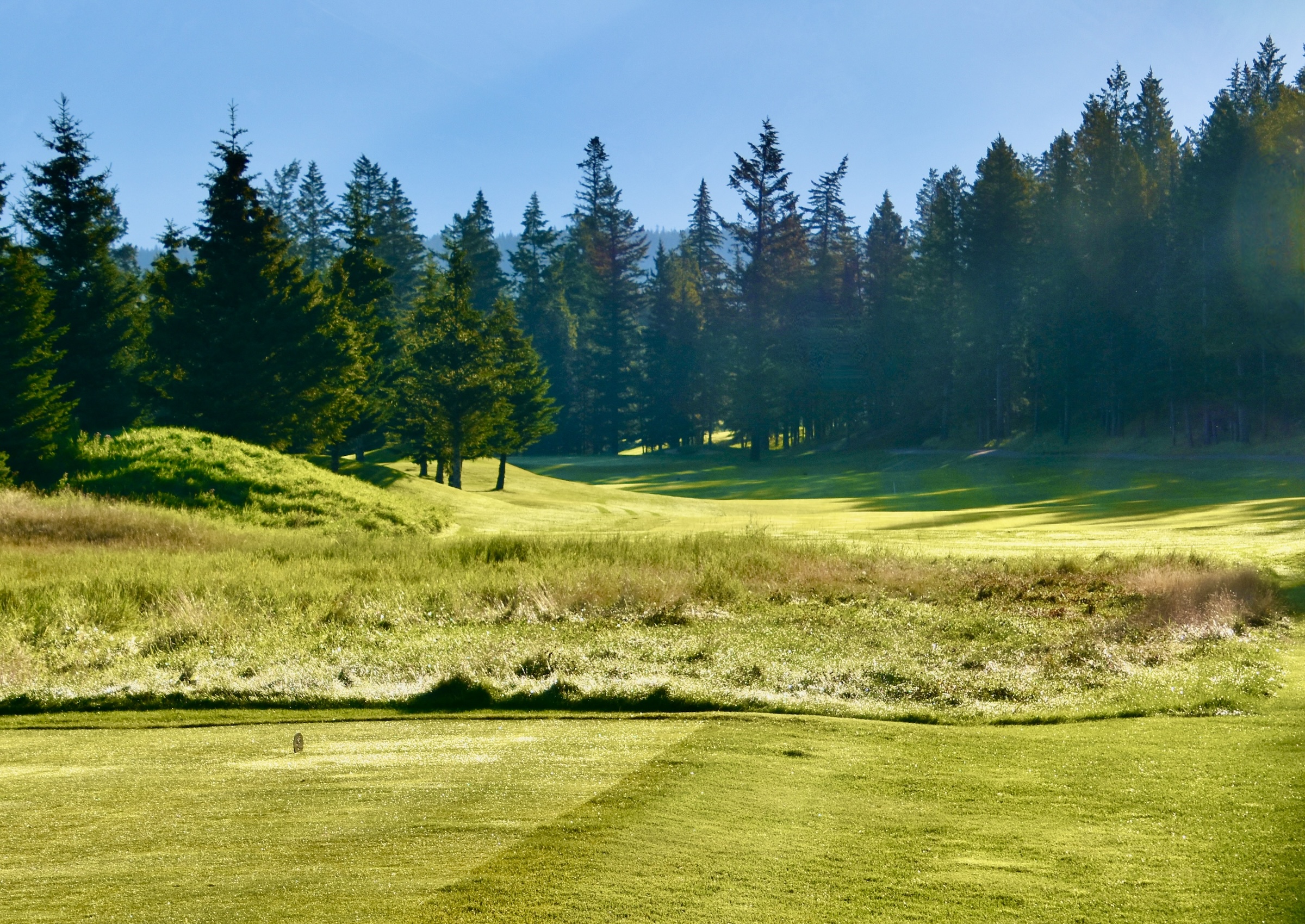
From the tips Banff Springs can play as long as 6,938 yards, but I will be playing it forward from a combination of white and gold tees that is 6,019 yards.
I like courses where each of the holes has a name, something that is de rigeur on links courses, but not seen enough in North America. This hole is named for Mount Peechee which in turn was named after Sir George Simpson’s Metis guide Alexis Piché. This is a perfect starting hole for my right to left ball flight and I had no doubts about hitting driver here.
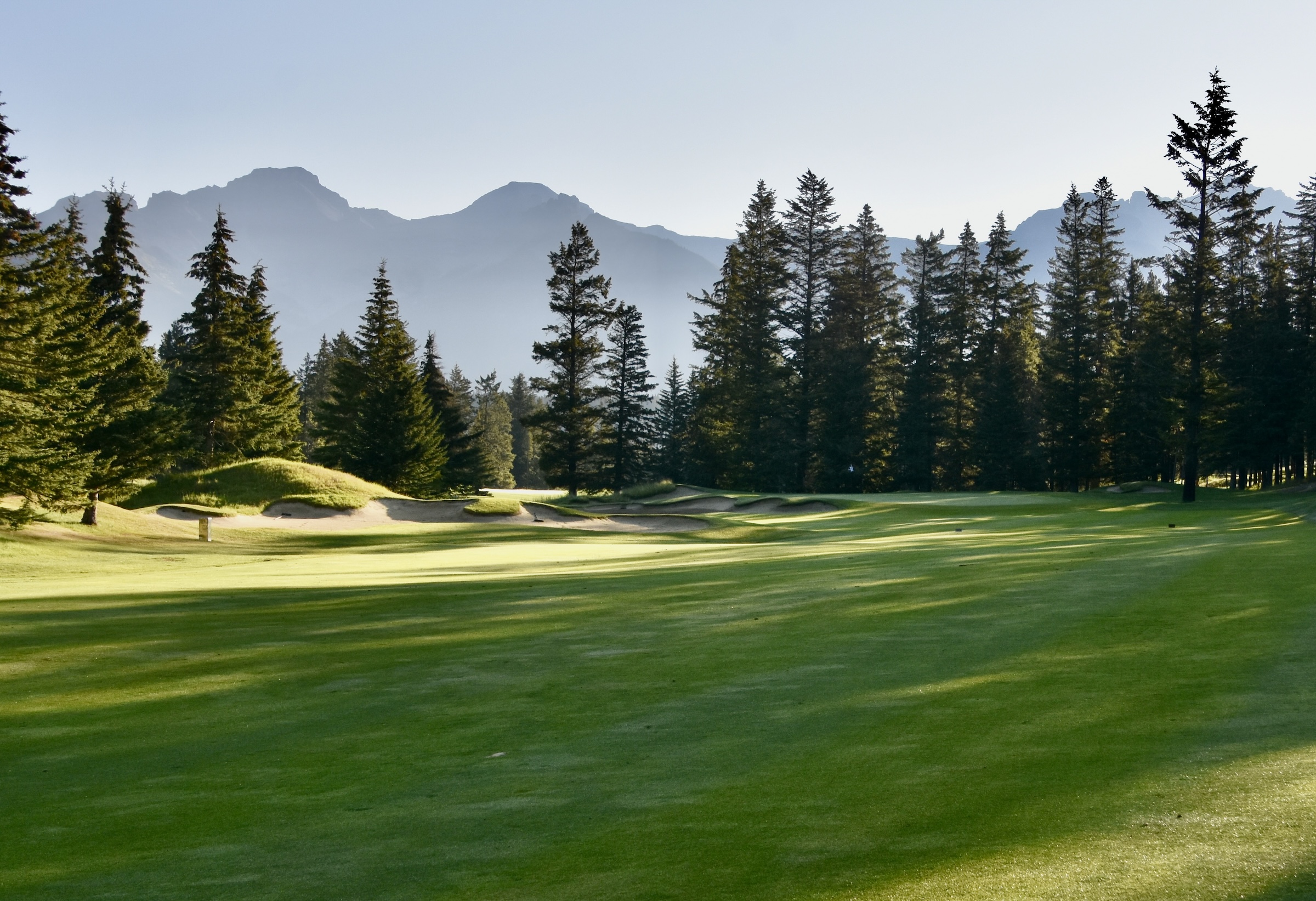
Mount Peechee now comes into view to the left of the green. Suddenly my right to left ball flight is not looking like such an asset with trouble everywhere to the left. However, before I pick a club, just look at how lush and immaculate the conditioning is at Banff Springs. It is an Audubon Cooperative Sanctuary course which means it uses minimal fertilizers and herbicides and uses sustainable irrigation practices. The program has proven that golf courses around the world can reduce their environmental footprint without sacrificing conditioning. Banff Springs is a course that is famous for its wildlife and the Audubon program is a natural fit for both the golfers and the wildlife.
Ok, with that little aside, I opt for a hybrid and aim for the far right side of the green. It comes up just short and I settle for a bogey. No worries, it’s just fantastic to finally get to play this great course.
#2 Rundle – 147 Yard Par Four
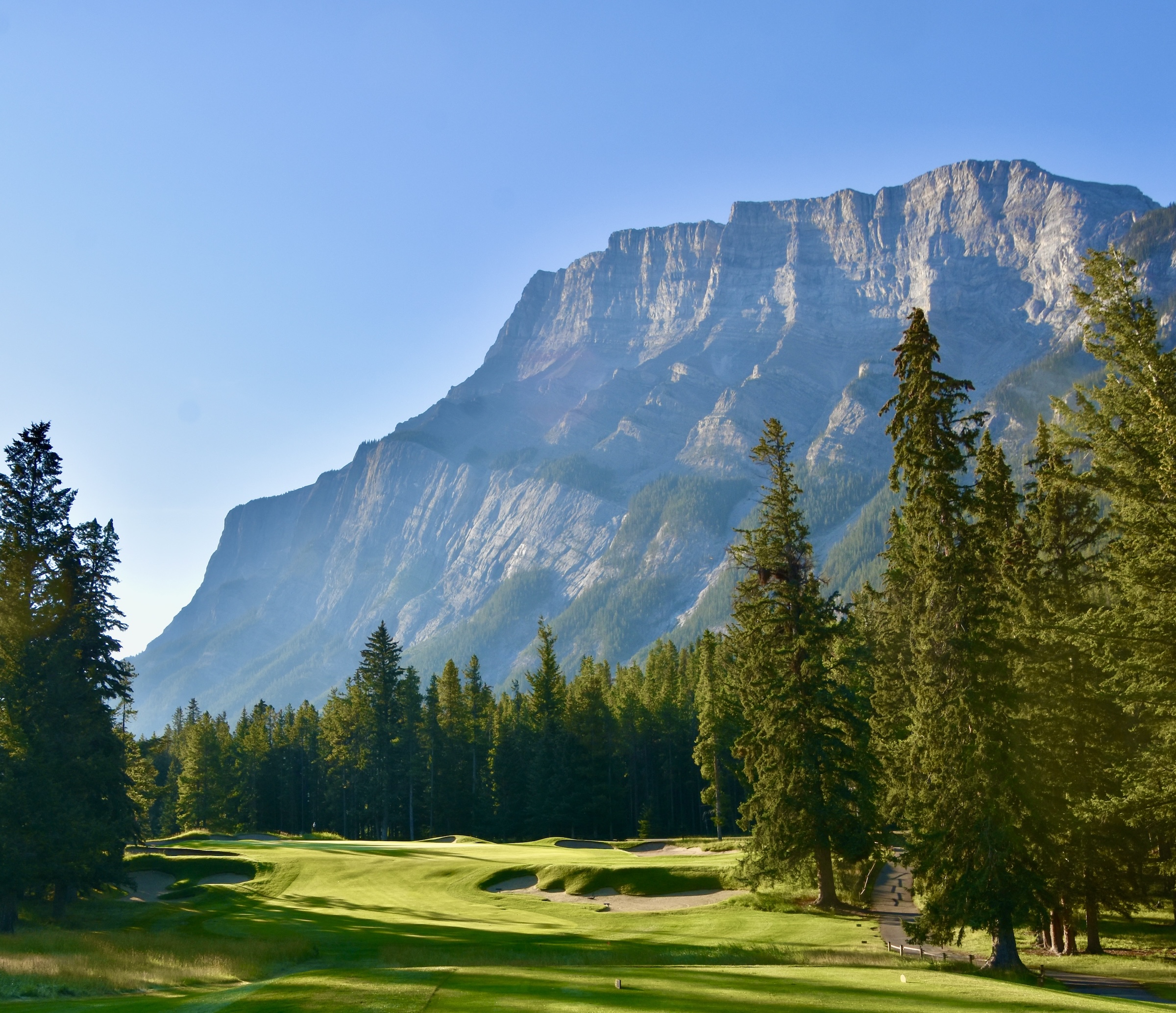
This hole is named for Mount Rundle, named for Jesuit priest who came to the area in the early 1800’s. At 2,949 metres (9,675 feet) it towers over the town of Banff and this wonderful looking golf hole. If you’ve got 8 hours to spare and very strong legs you can hike to the very top from a trailhead that starts not that far from this spot.
Alison and I will stick to golf.
Club selection is everything on this hole, Fortunately the pin is quite far back today which should take the traps on the right out of play. I opt for a six iron that does the job and the first par is on the card.
Banff Springs #3 Gibraltar – 465 Yard Par Five
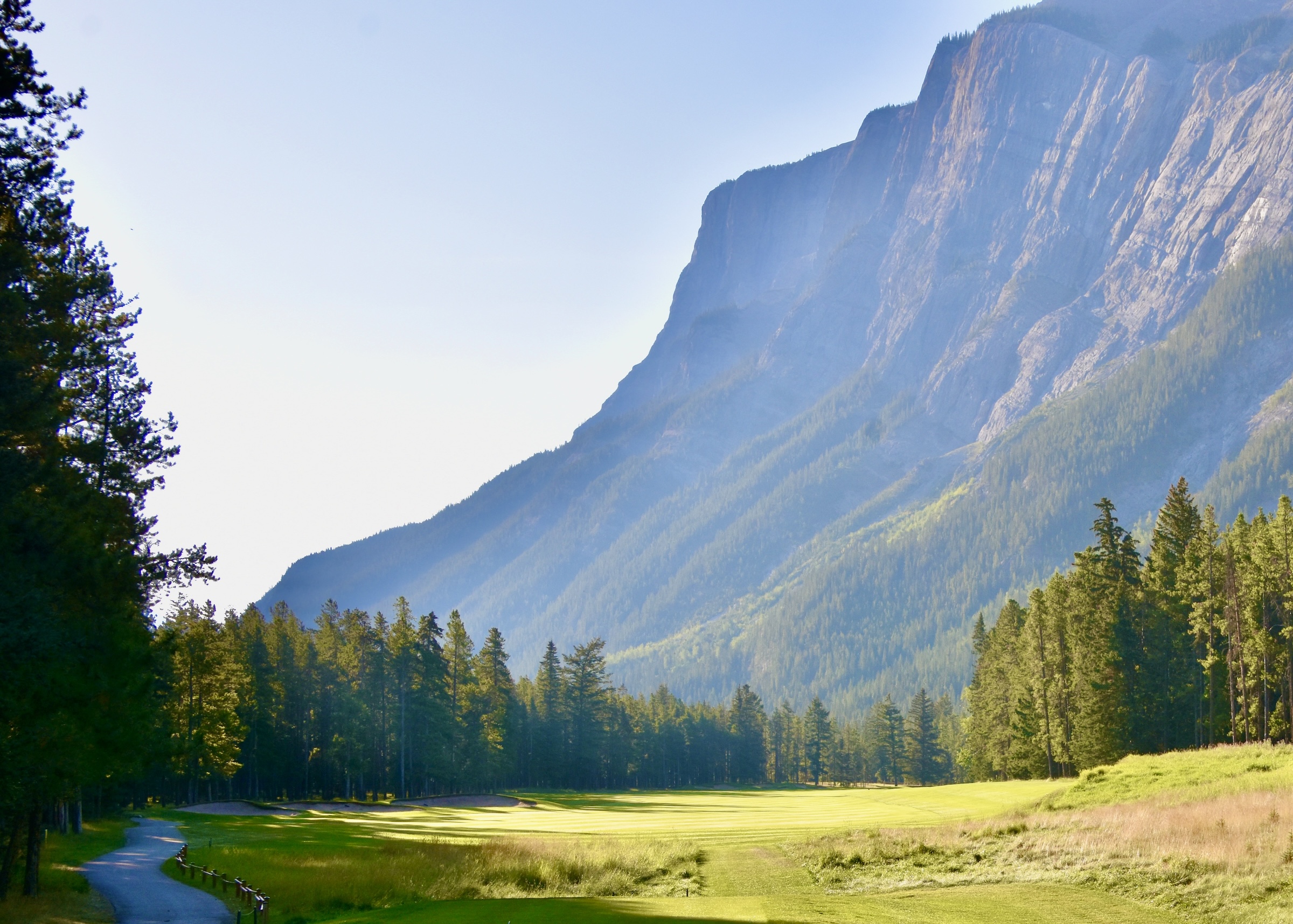
No reason to explain the name of the hole here, it’s pretty obvious and pretty stunning.
The first par five at Banff Springs is a relatively benign 465 yards, but as readers of my posts will know, at my age I always play the par fives as three shot holes and hope for a birdie putt. The bottom line for me and I think most average senior golfers is to forget about eagles and concentrate on pars on holes like this. Hitting a three wood takes the fairway bunkers on the left out of play.

There’s still lots of room for the second shot so a second three wood is in order.
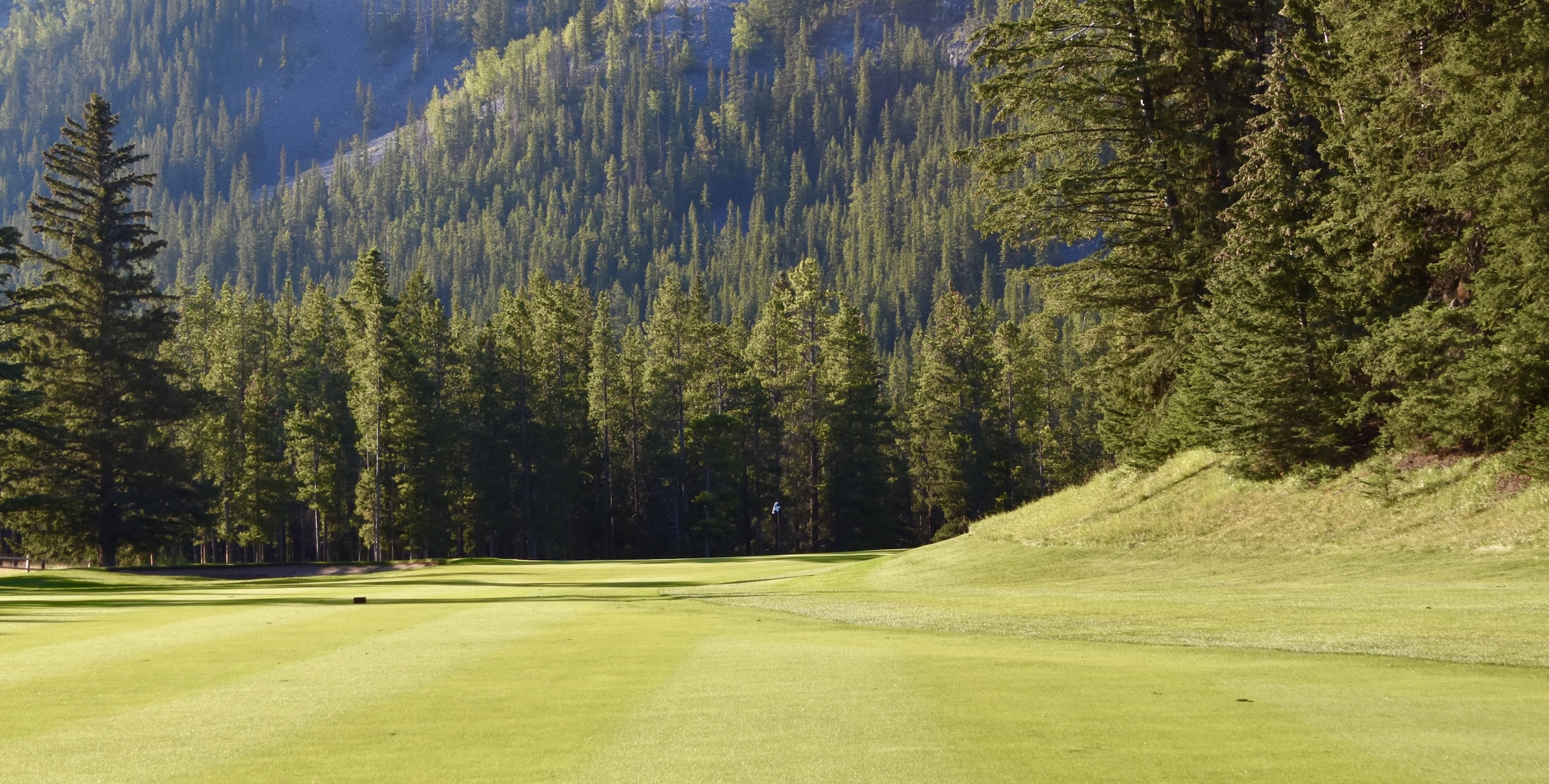
As I find out after the fact, I should have aimed much more to the left on the second shot. I’m now left with this tricky pitch shot. I could go for the flag, but even a slight mishit might bring that overhanging tree on the right into play. Instead I opt for the left side of the green and settle for a two putt par.
Stanley Thompson was not a believer in heavily contoured greens and while they definitely have subtle breaks that can lead to misreads, if you get to them in regulation three putts should be rare.
#4 Devil’s Cauldron – 165 Yard Par Three
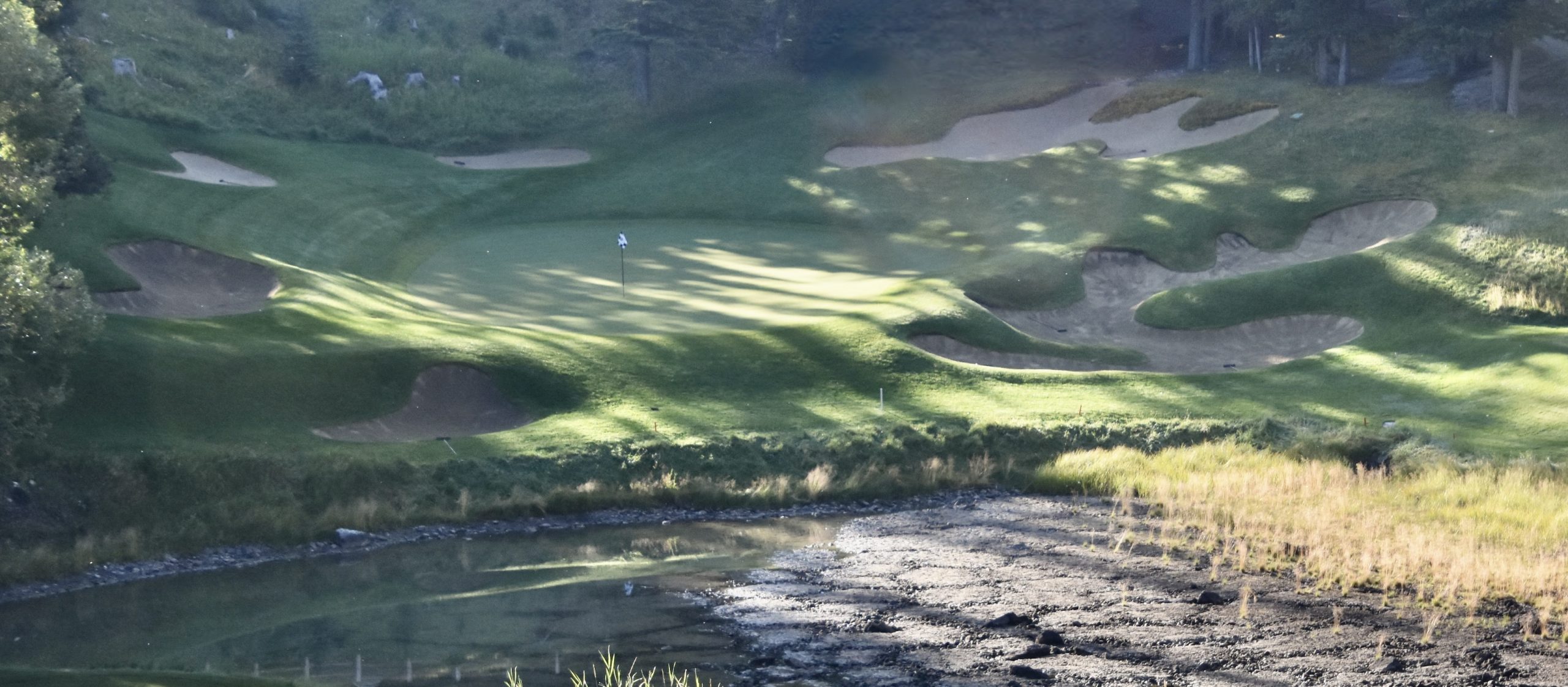
Golf Magazine named Devil’s Cauldron as one of the best 18 holes in the world. There is a 70 foot drop from the tee to small green that is almost completely surrounded by bunkers. There is absolutely no bail out option on this hole. While the green does resemble a cauldron in some respects, I think the name comes from the octagon formations in the pond that bring to mind a bubbling cauldron right out of MacBeth.
You can see that more clearly from this aerial shot taken by my friends at Golf Course Gurus.
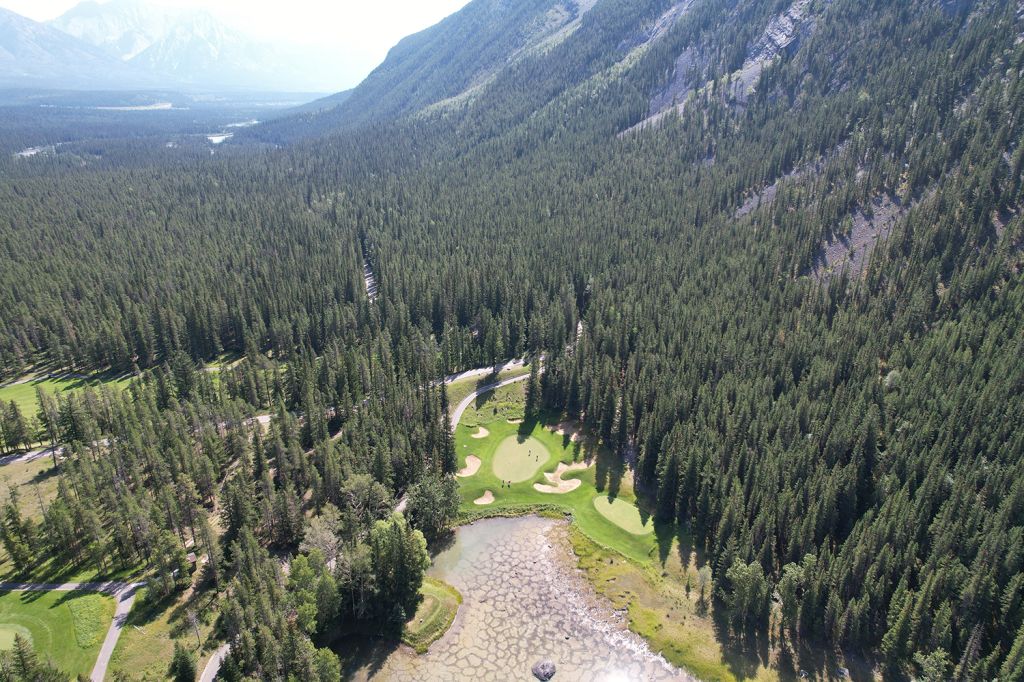
This is a daunting tee shot by any standards and I confess to overestimating how much club to take off due to the elevation change and ending up in the front left bunker, which is way deeper than it looks from this photo. Escaping with a bogey is no embarrassment on this once in a lifetime par three.
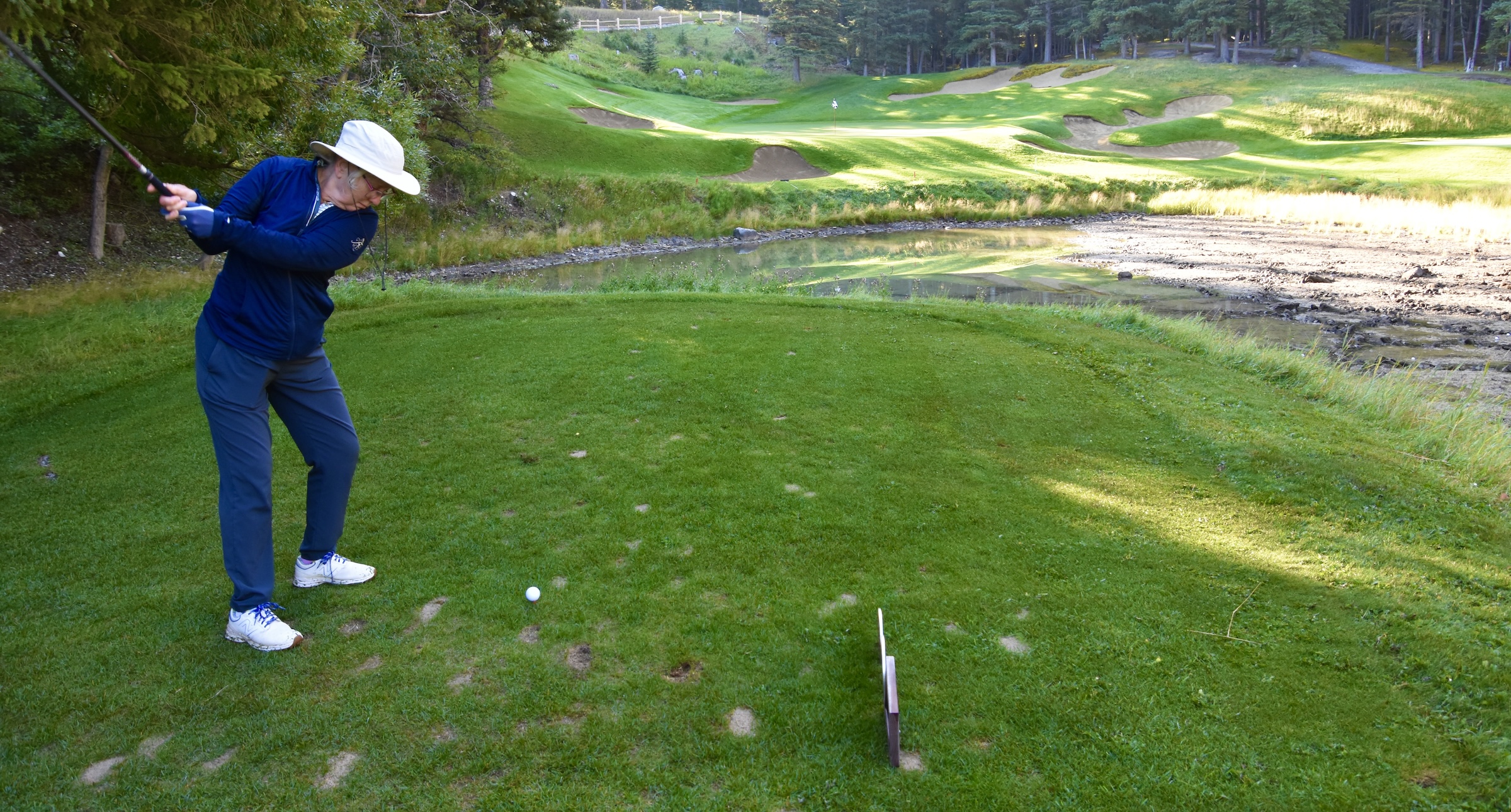
From the ladies’ tee, it’s actually a completely different hole that requires an uphill shot which Alison was able to pull off and net a par that will be long remembered.
Banff Springs #5 Trough – 359 Yard Par Four
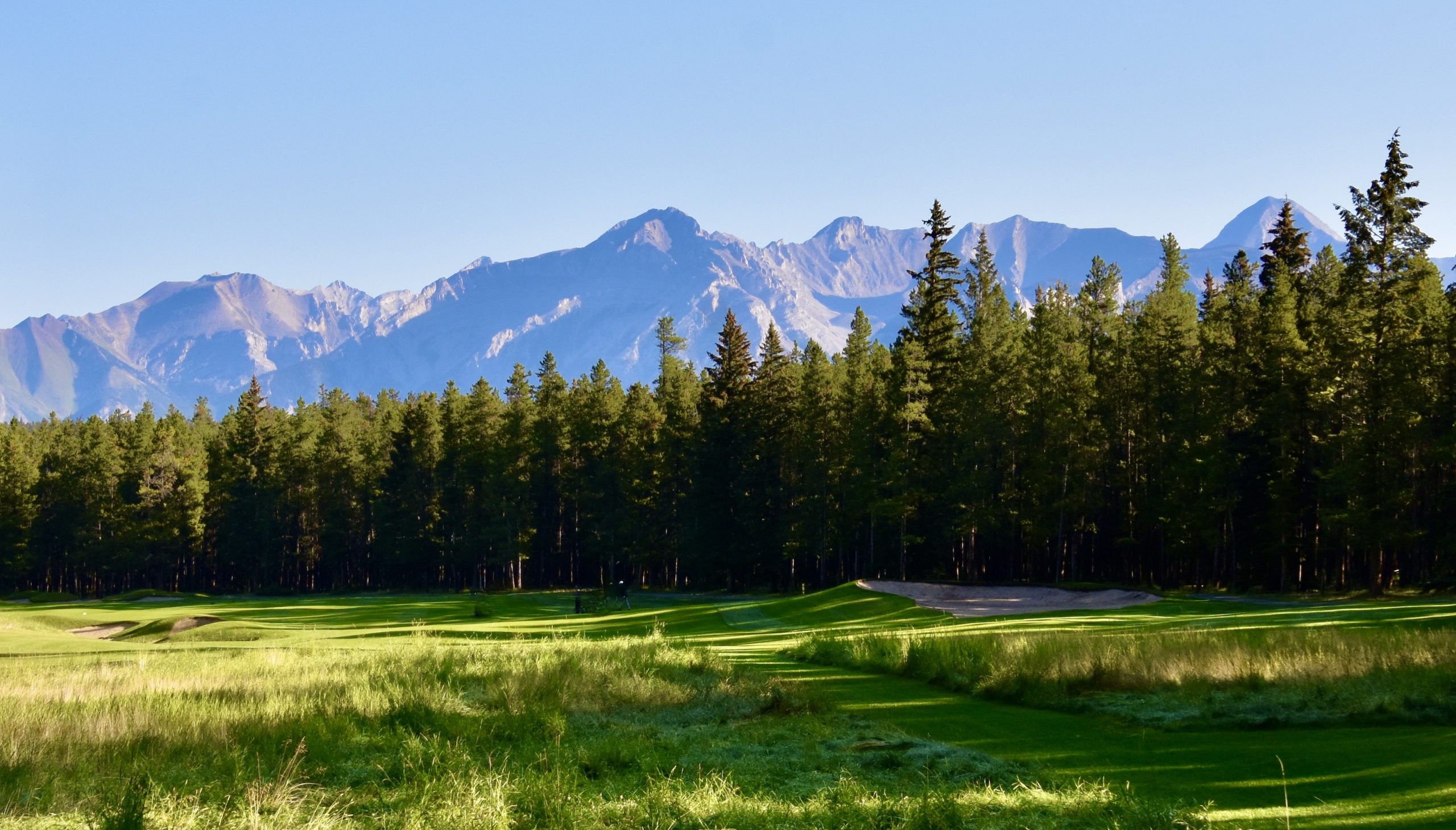
There is a small trough that runs the length of this hole, but it’s not really an issue as a hazard. Like #1, this right to left dogleg is perfect for my ball flight as long as I can avoid the traps on the left.
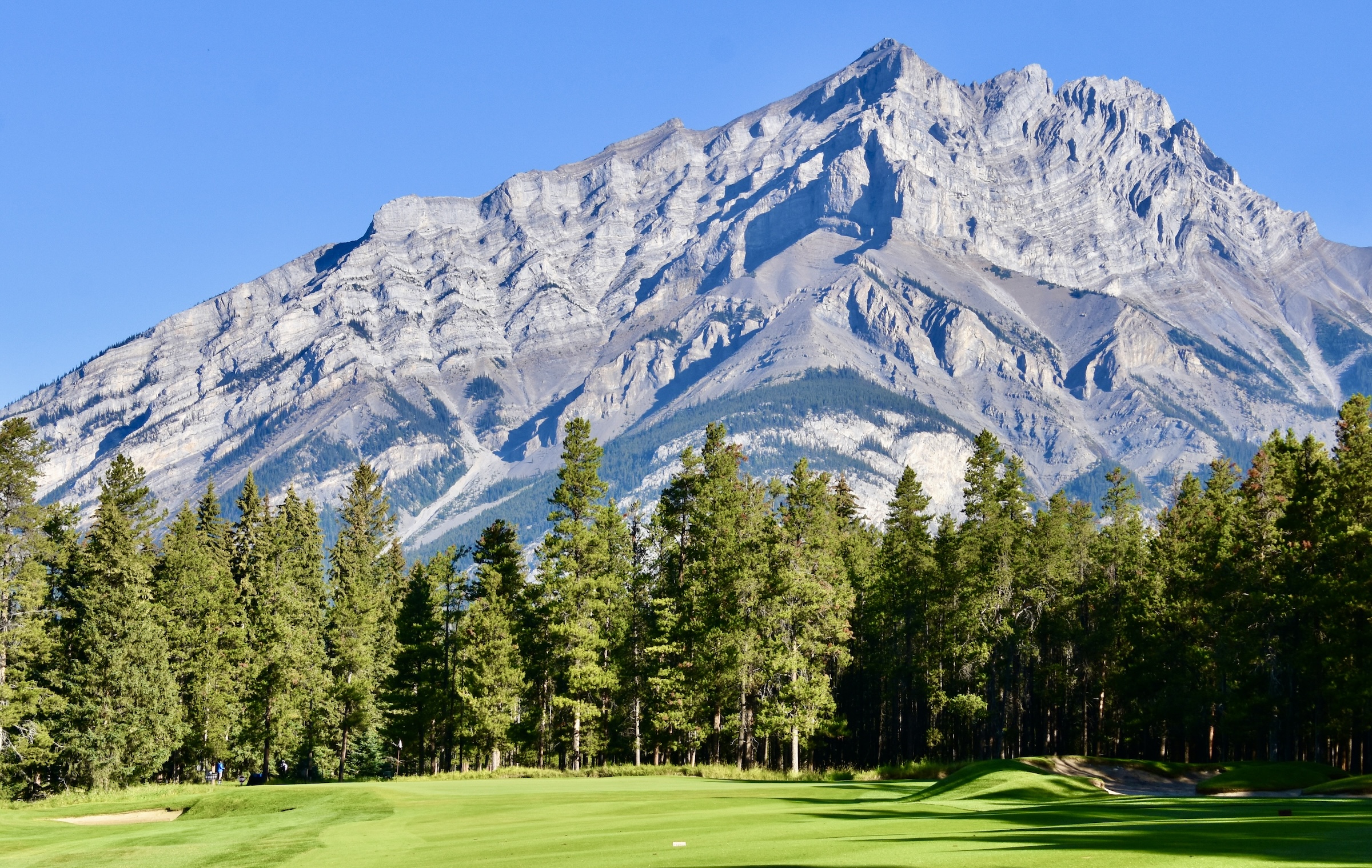
I do avoid the traps and am rewarded with this absolutely amazing approach shot. If this isn’t the essence of mountain golf, then nothing is. It’s a relatively straightforward mid-iron to a flat green that yields a par.
#6 Fairholm – 344 Yard Par Four
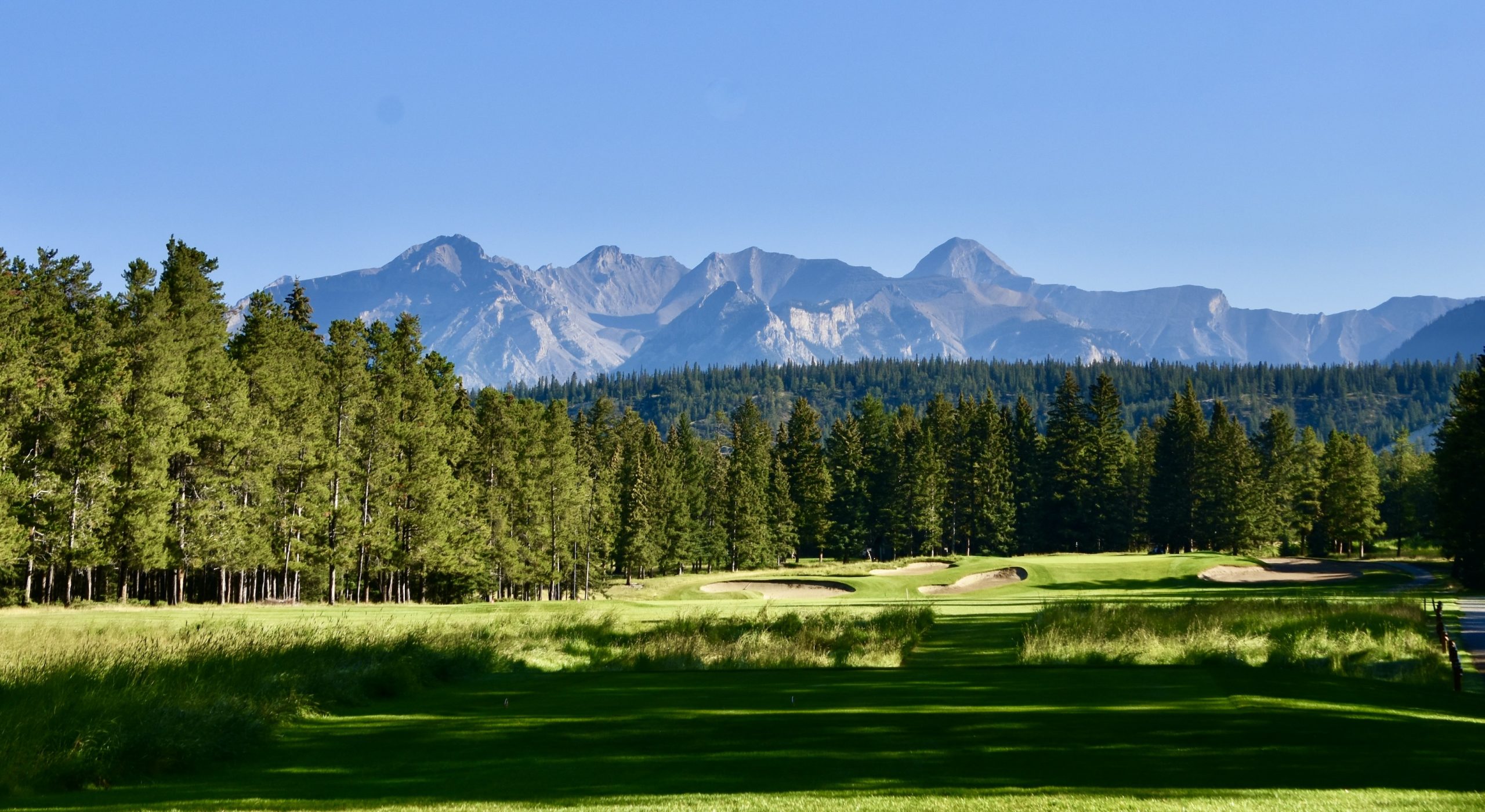
This hole, named for the Fairholm Range which makes the backdrop for yet another beautiful hole, was part of the Donald Ross course and left relatively intact by Stanley Thompson. This photo makes it look like the traps are in play off the tee, but they aren’t. This is a super wide fairway by Thompson/Ross standards and you can let it rip here because you want as short an approach shot as possible.
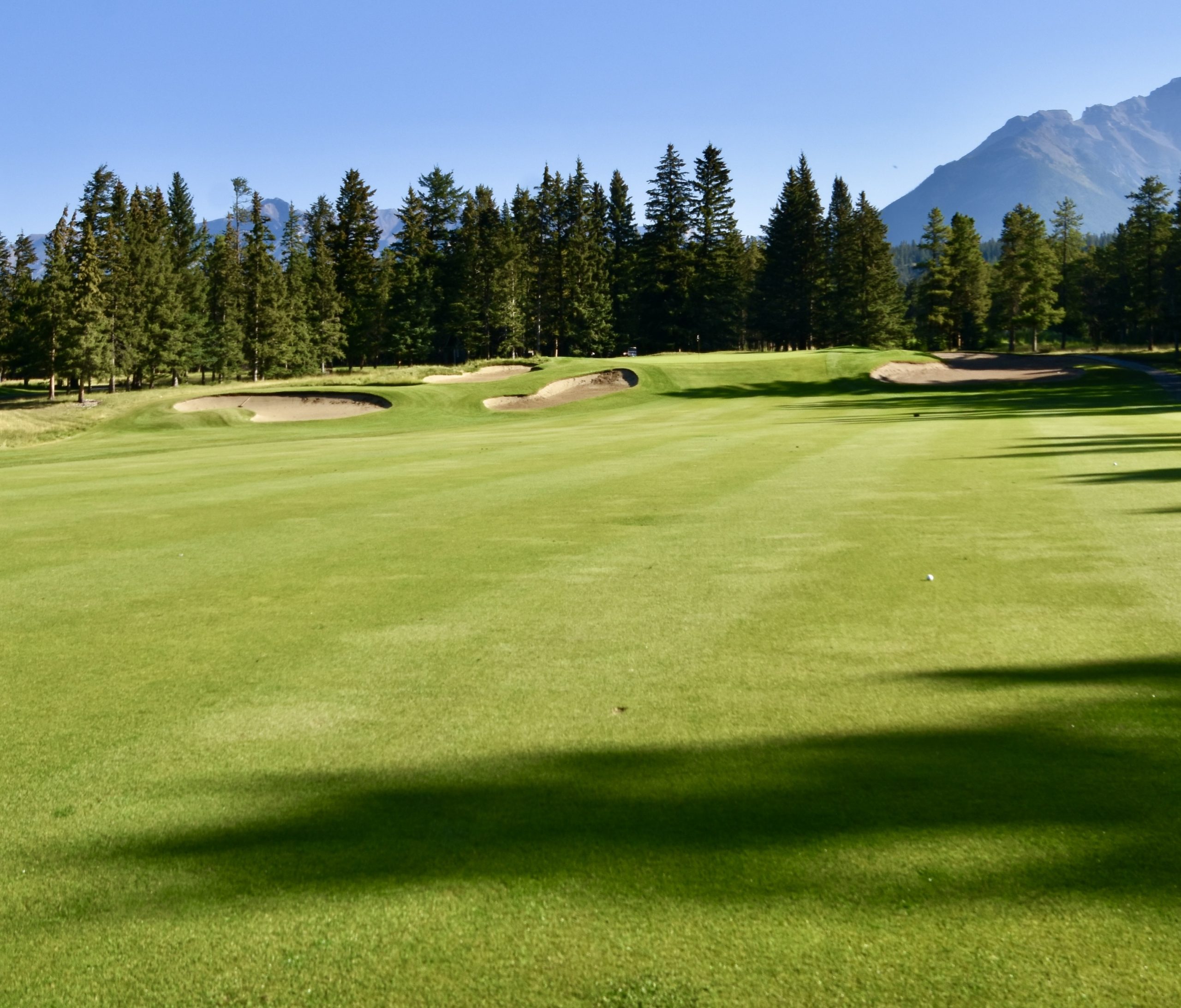
This is a classic Donald Ross raised and somewhat crowned green with a false front; pretty to look at, but hard to obtain. Your short iron needs to be perfectly struck to this small green that is surrounded by bunkers that collectively are three times the size of the green. Mine wasn’t. Enough said.
Banff Springs #7 Hoodoo – 517 Yard Par Five
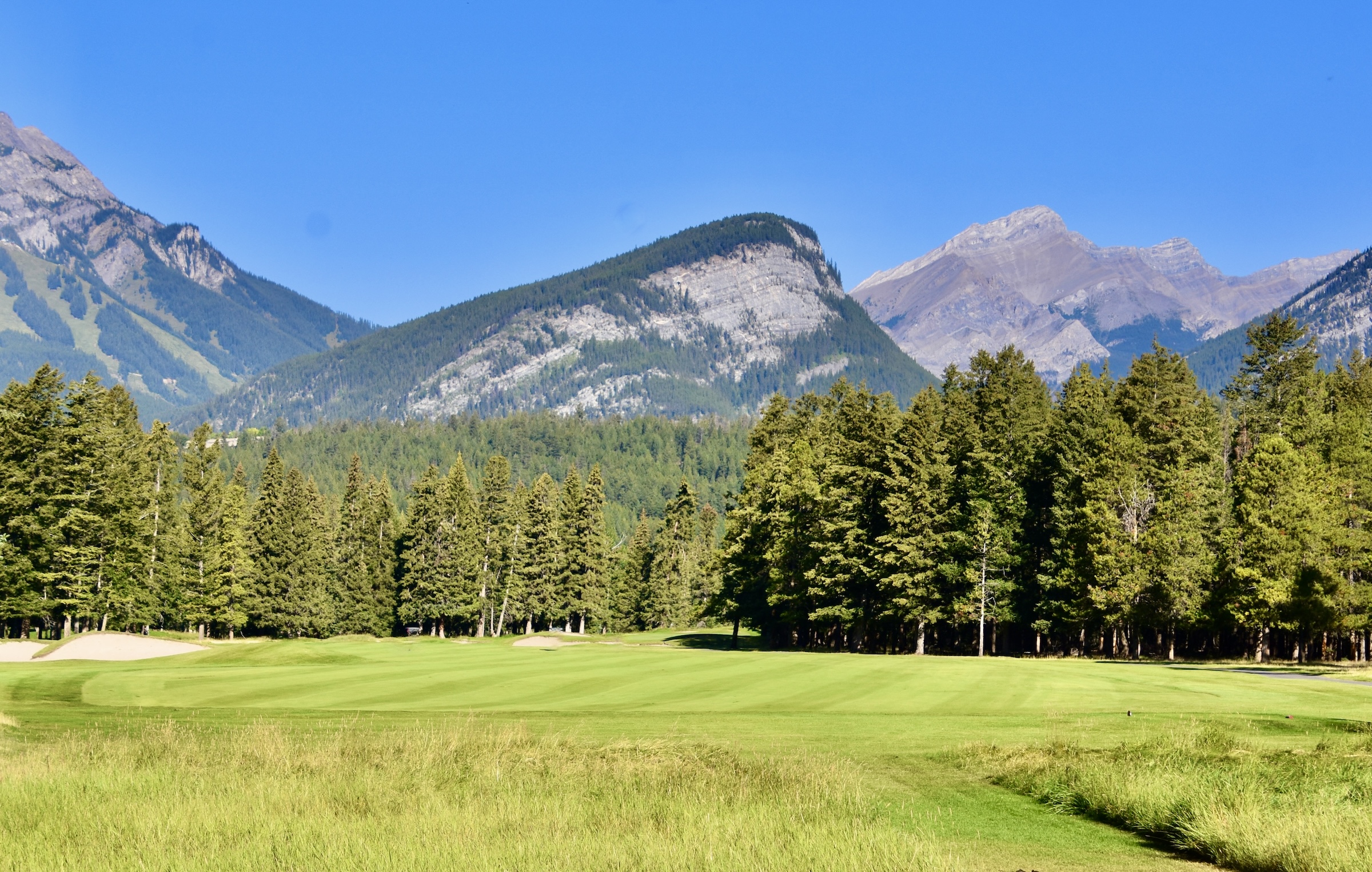
This is the #1 stroke hole at Banff Springs and requires it to be played delicately to say the least. By that I mean getting into position with your third shot to have a clear approach to the green while avoiding the very strategically placed bunkers. The drive is not the problem here – you can hit driver. With my ball flight I had to aim at the right tree line to avoid the left side bunker which is very much in play.
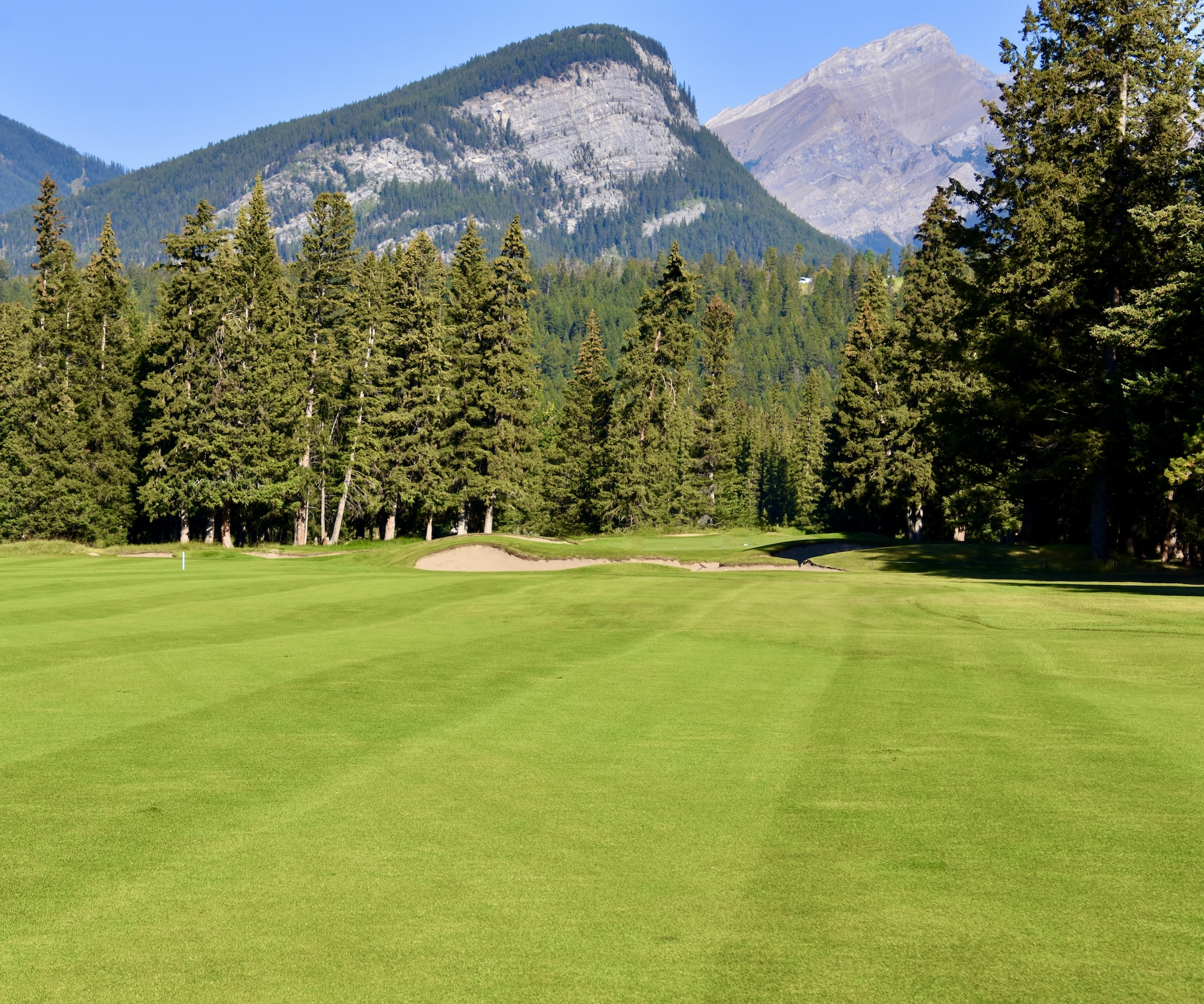
While I did avoid the bunker, I now have this quandary. That bunker straight ahead is massive, maybe the largest Thompson ever built. It looks like an easy carry, but it’s not. This is one of the most difficult second shots on a par five you will ever face.
Here’s a look at the situation from above courtesy of the Golf Course Gurus again.
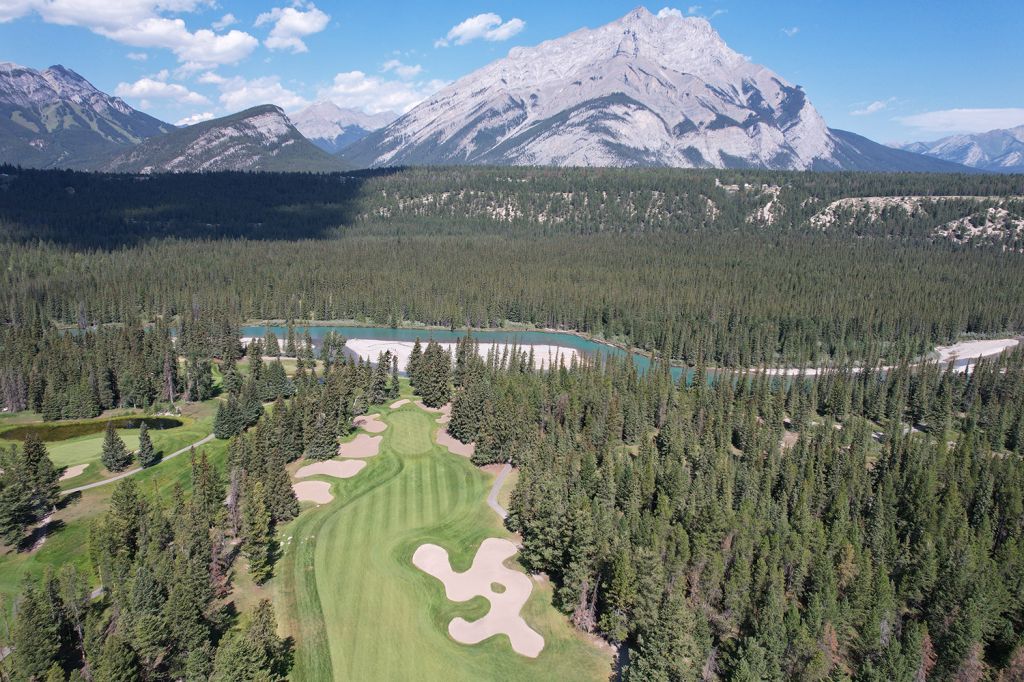
As you can see, you need to get over the right side bunker and stay short of the bunkers on the left. The landing area is only about 10 or 12 yards wide.
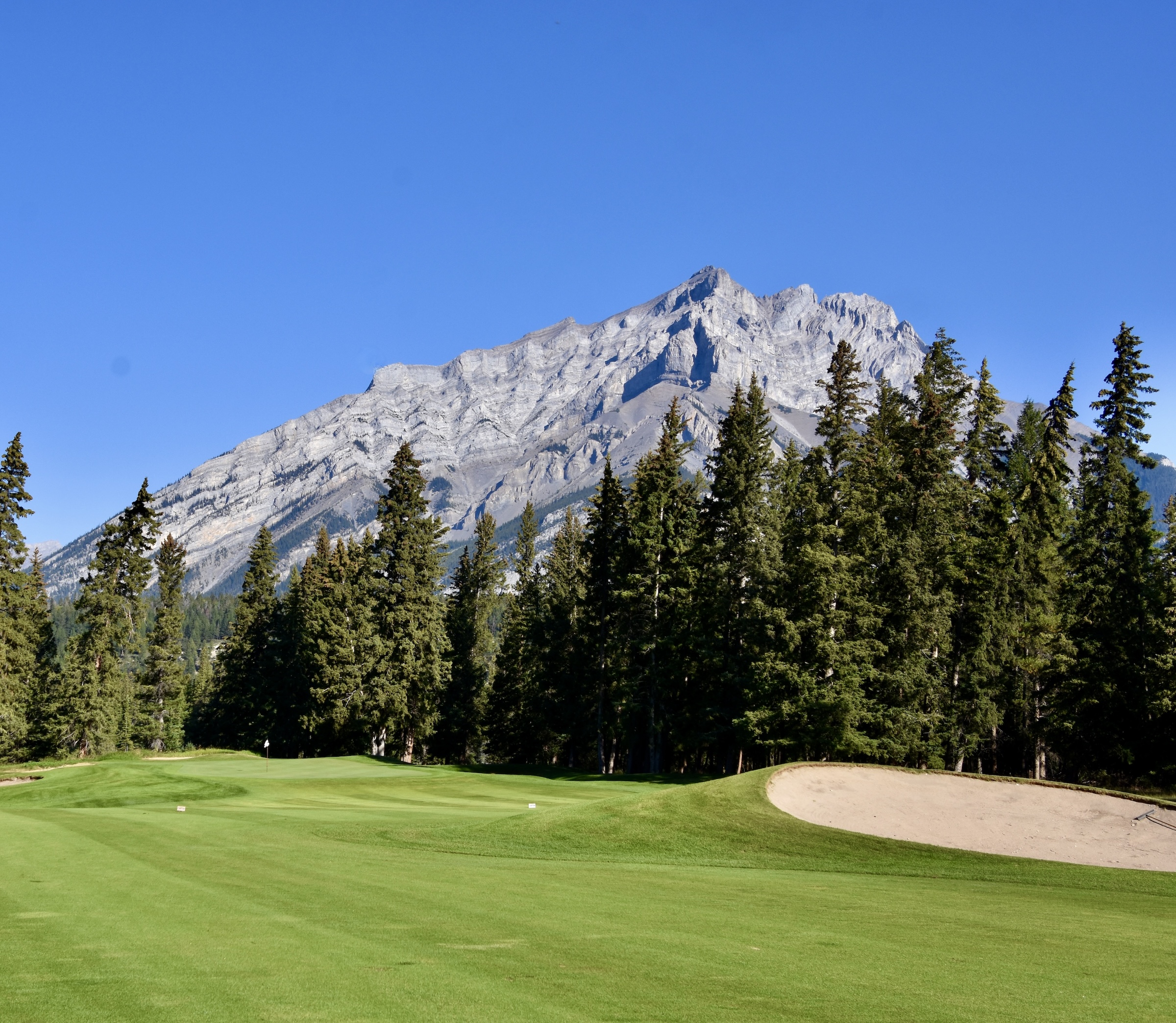
You can see from this photo that I just chickened out, put the wood back in the bag and hit a seven iron up to the 150 yard marker. It’s a way longer third shot than I would have liked and it took four to get down from here, but bogey is no disgrace on this wicked par five.
BTW the name of the hole comes from the hoodoos you can supposedly see across the Bow River from the green in this hole, but I couldn’t find them. In case you’re wondering, this is what a hoodoo looks like. Maybe they were on vacation when I played.

#8 Papoose – 125 Yard Par Three
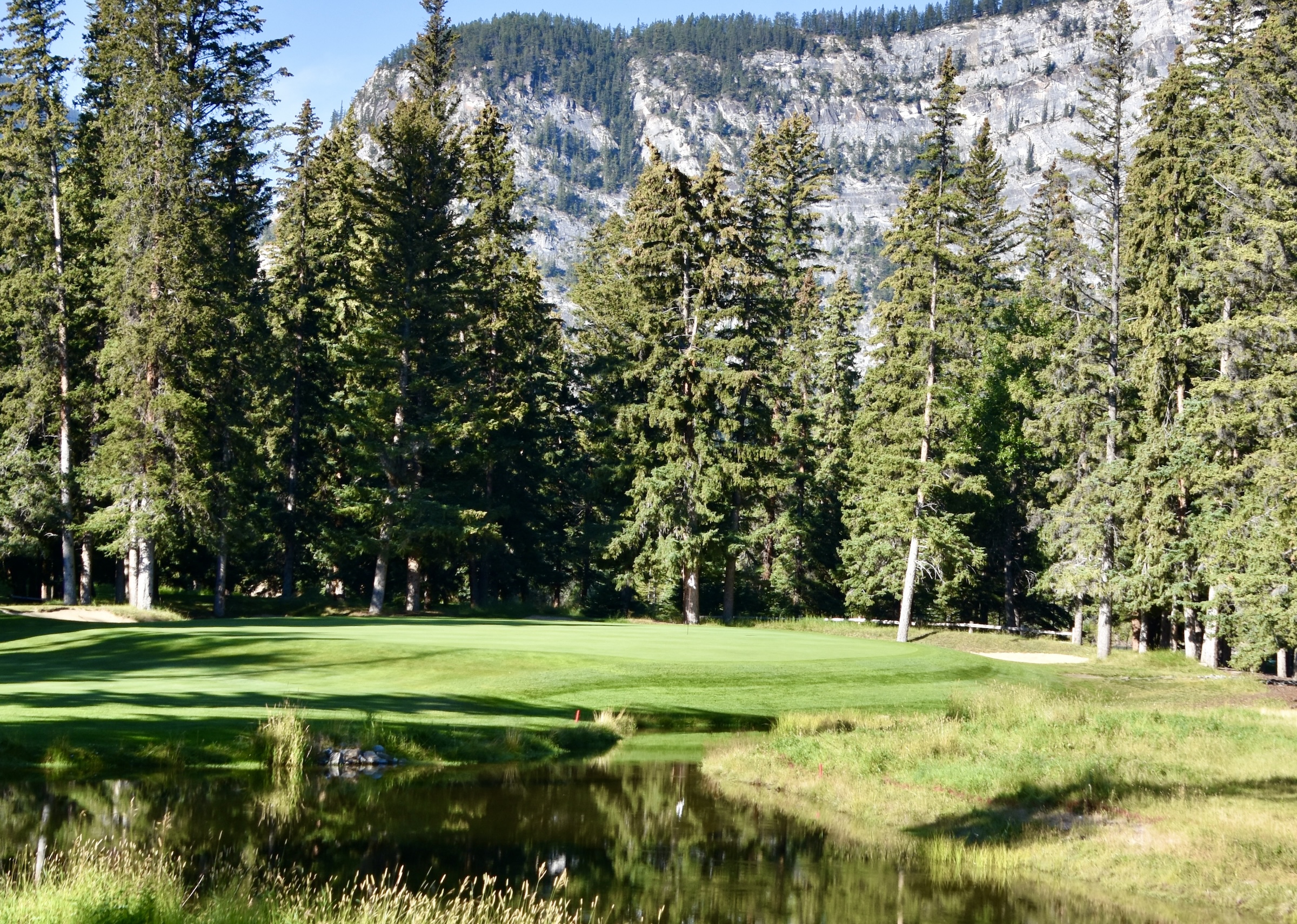
Papoose is an Indigenous name for a baby and at only 125 yards this is the baby hole of Banff Springs. However, if it’s anything like Thompson’s Bad Baby #15 at Jasper Park Lodge hold on to your hat.
Thank God it’s not and this clocks in as the easiest hole on the front and a happy respite after #7. A three sure makes a six feel better.
Banff Springs #9 Jinx – 458 Yard Par Five
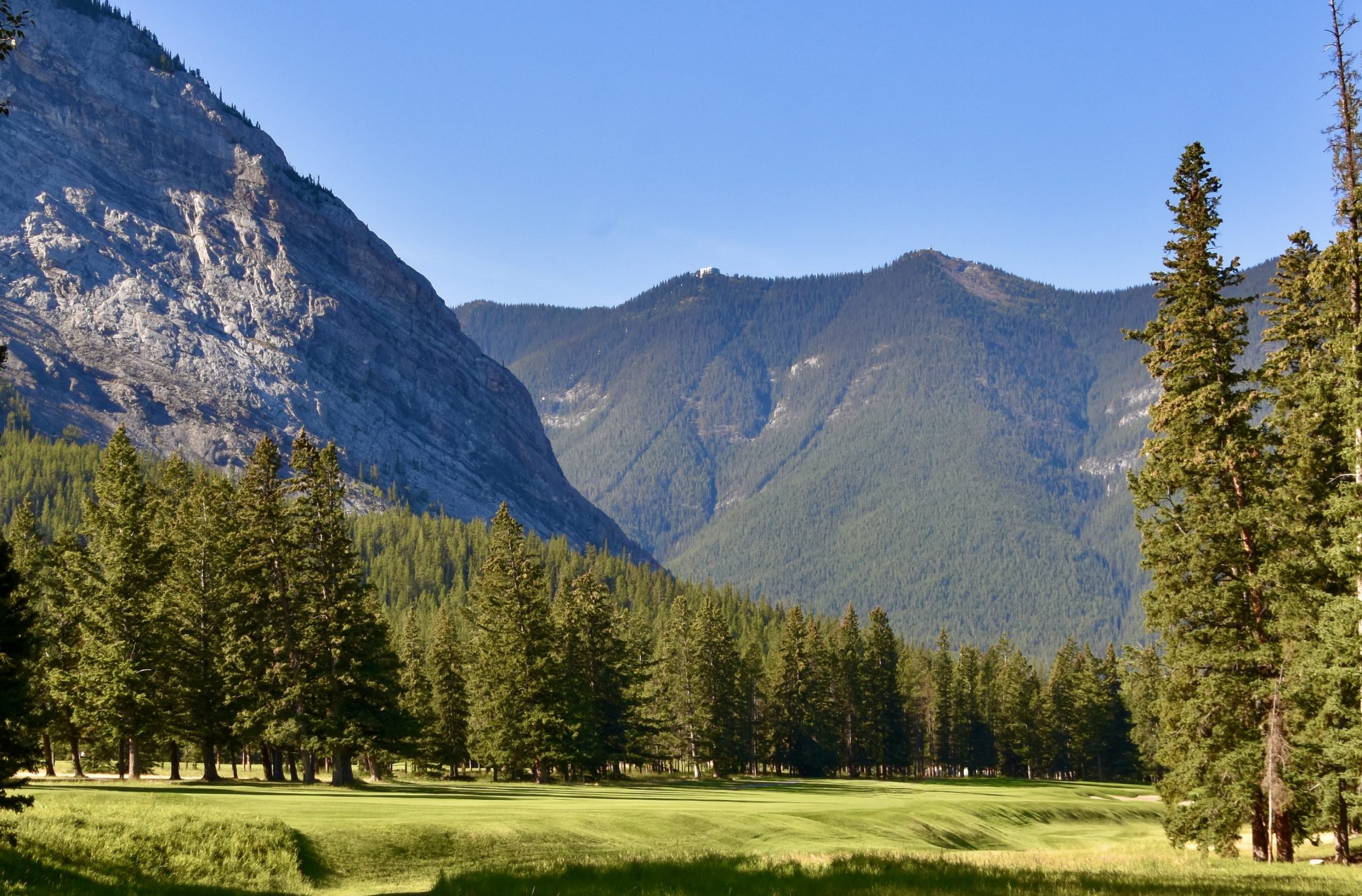
The third par five on the front starts off with a drive to a fairly narrow fairway, so three wood is the better choice than driver. There is a trough that you can see on the right side that runs down the entire length of the fairway and could be an issue for righties. Although the photo doesn’t show it, the Bow River runs down the entire right side as well, but it would take a wild slice to land in it. For me that would be a hook and I don’t do hooks.
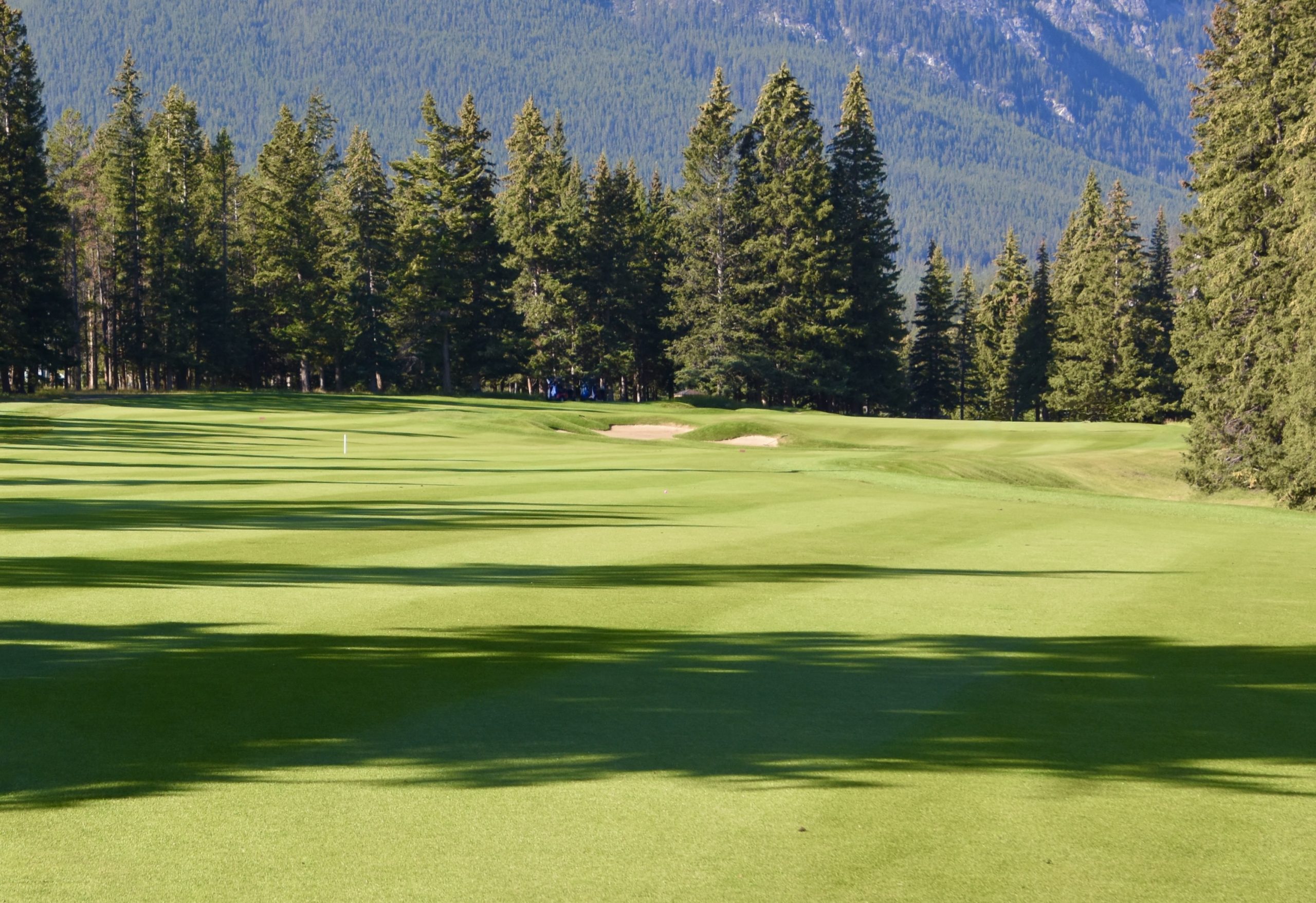
Didn’t I just see this same second shot predicament two holes ago? Actually not. That massive trap is between me and the green, but it’s further away than it looks. It’s there to suck in would be heroes going for the green in two. I’m not one of them and I use the room out to the left to land a hybrid.
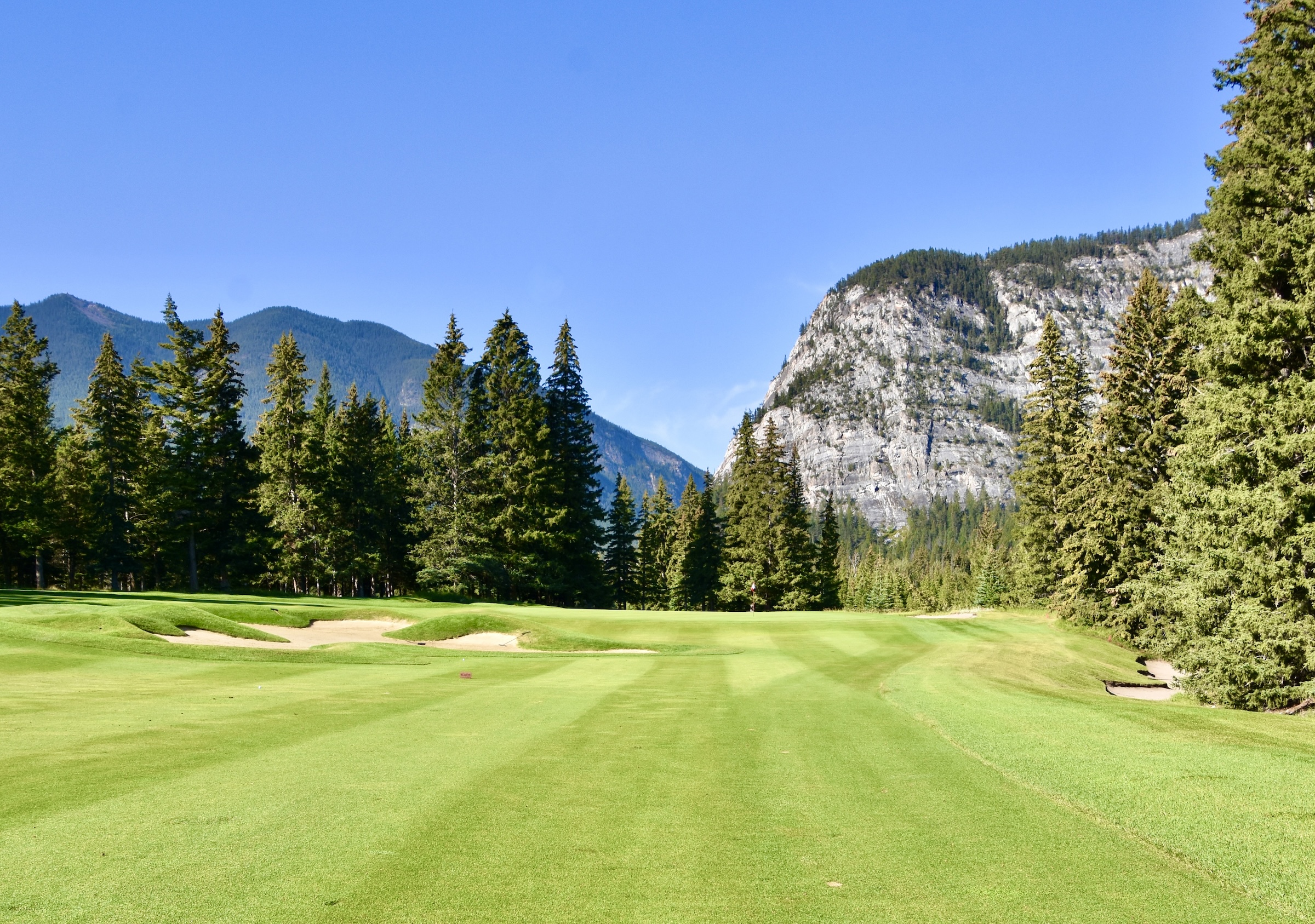
That leaves this approach to a small slightly elevated green that holds a decent wedge shot and another par to end off the front nine.
#10 Little Bow – 128 Yard Par Three
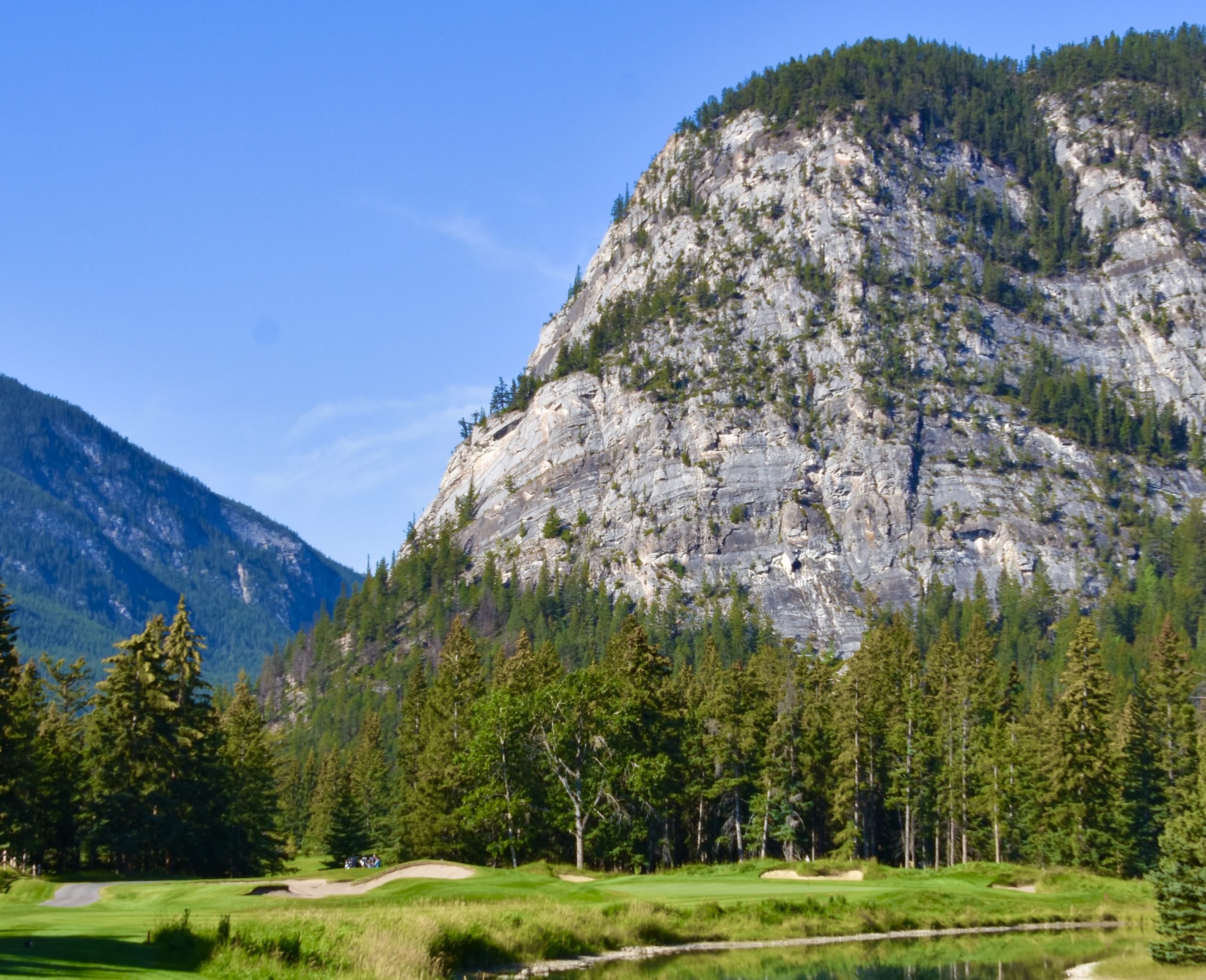
This is the view from the white tees on this lovely par three with Tunnel Mountain in the background. It plays almost 200 yards and is pretty well all carry. I’ll be playing from the golds which has this look.
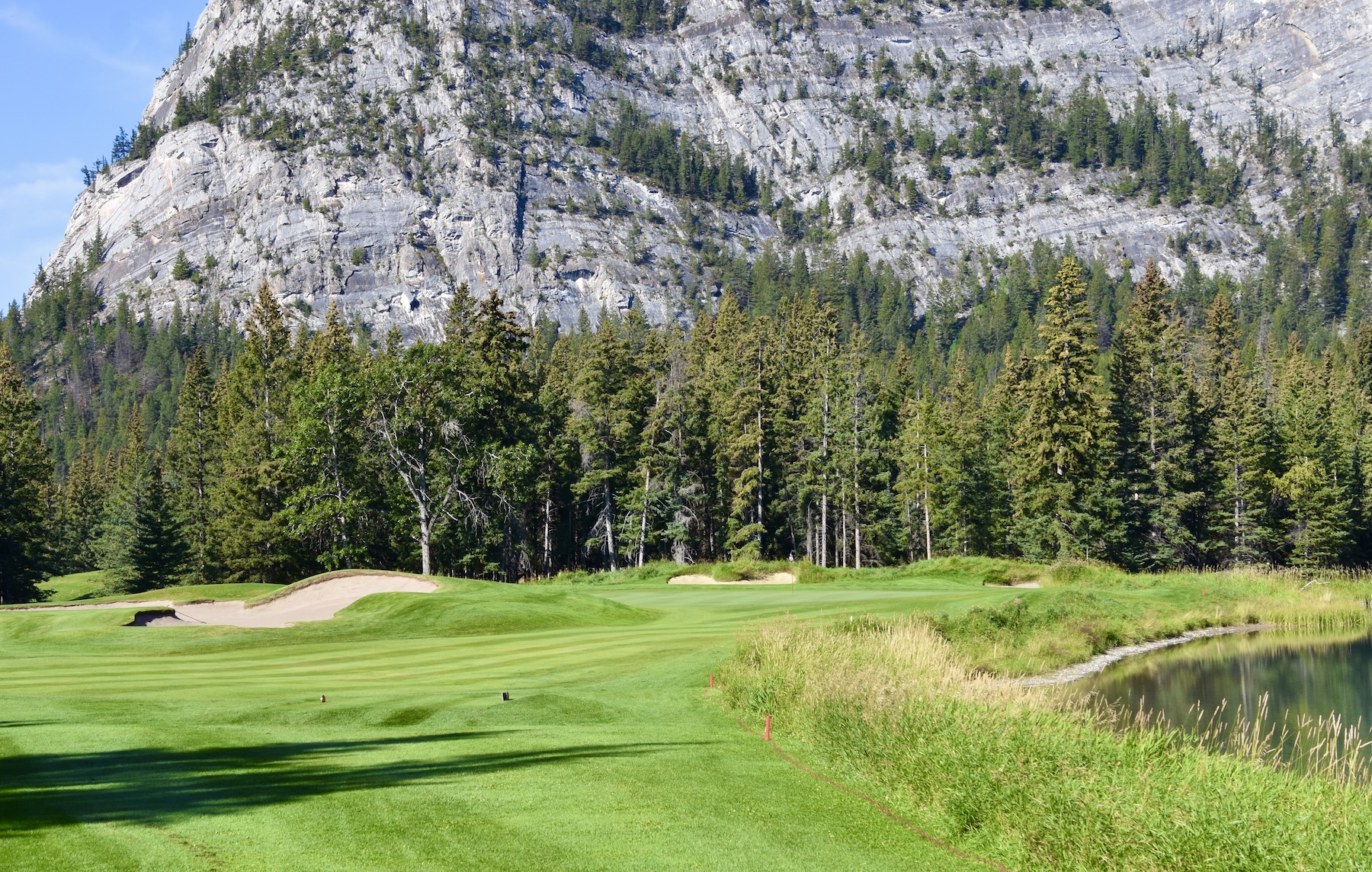
This is more like it. It’s a completely different hole from this tee box and requires an eight iron and not a wood as would have been the case from the white tees. This hole is a good example of Thompson’s ability to cater to golfers of all abilities.
Banff Springs #11 Magpie – 389 Yard Par Four
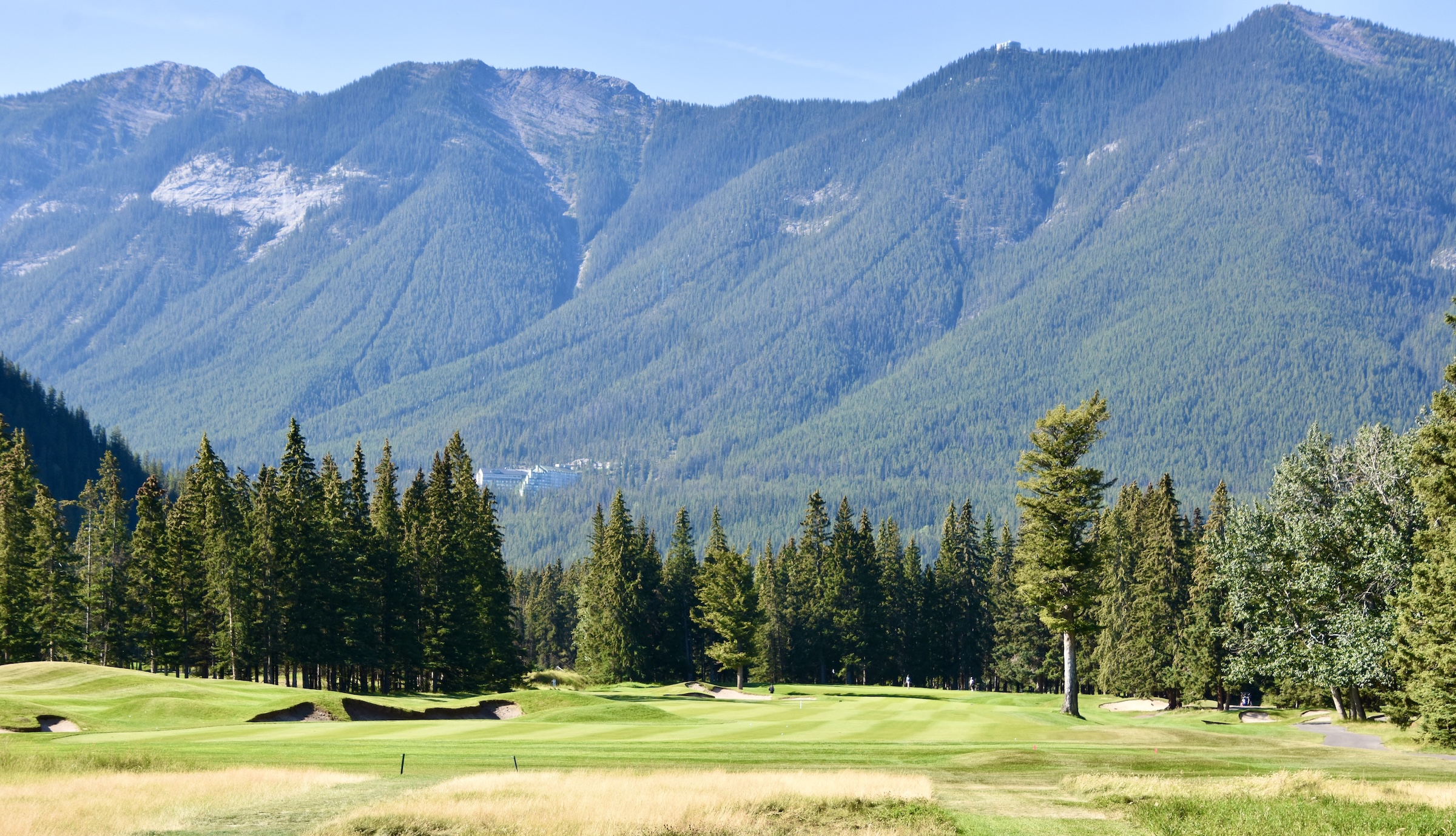
This hole, named for the pretty, but noisome birds that frequent the Banff area, is a good example of just how flat most of the holes are at Banff Springs. Although you. cannot see it from the tee the Bow River runs the length of this hole and in fact holes 8 through 14 all have the Bow River on the right side. It’s not really in play, but the sound of the running water is a pleasant addition to the ambience of this course.
This hole does require a driver and with those traps on the left, it’s a tricky shot that requires aiming at the tree on the right side of the fairway.
BTW the large building you can see at the base of the mountains is the Rimrock Resort, probably the swankiest in Banff after Banff Springs.

I’ve avoided trouble, but I’m still a good 180 yards out and I need to stay to the right to take the trap that protects the left side of the green out of play. I don’t and find the sand. Put a five on the card.
Although this is the #12 ranked stroke hole, I think it plays harder than that.
#12 Big Bow – 390 Yard Par Four
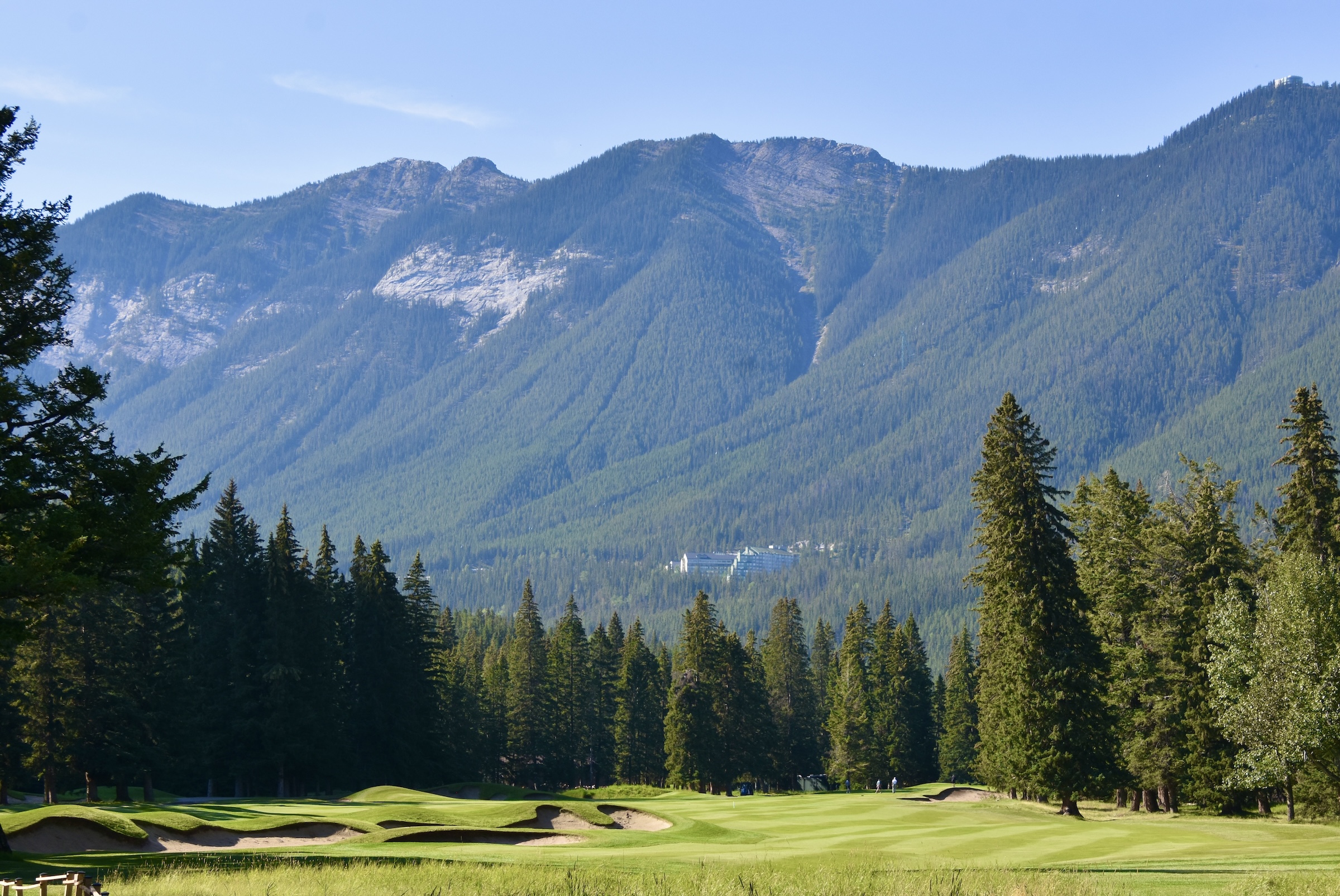
The second longish par four in a row is actually quite similar to the last hole – there’s trouble to the left and a protruding tree to the right that becomes my aiming target. However, you do want to be on the left side of this fairway for the best approach to the green.
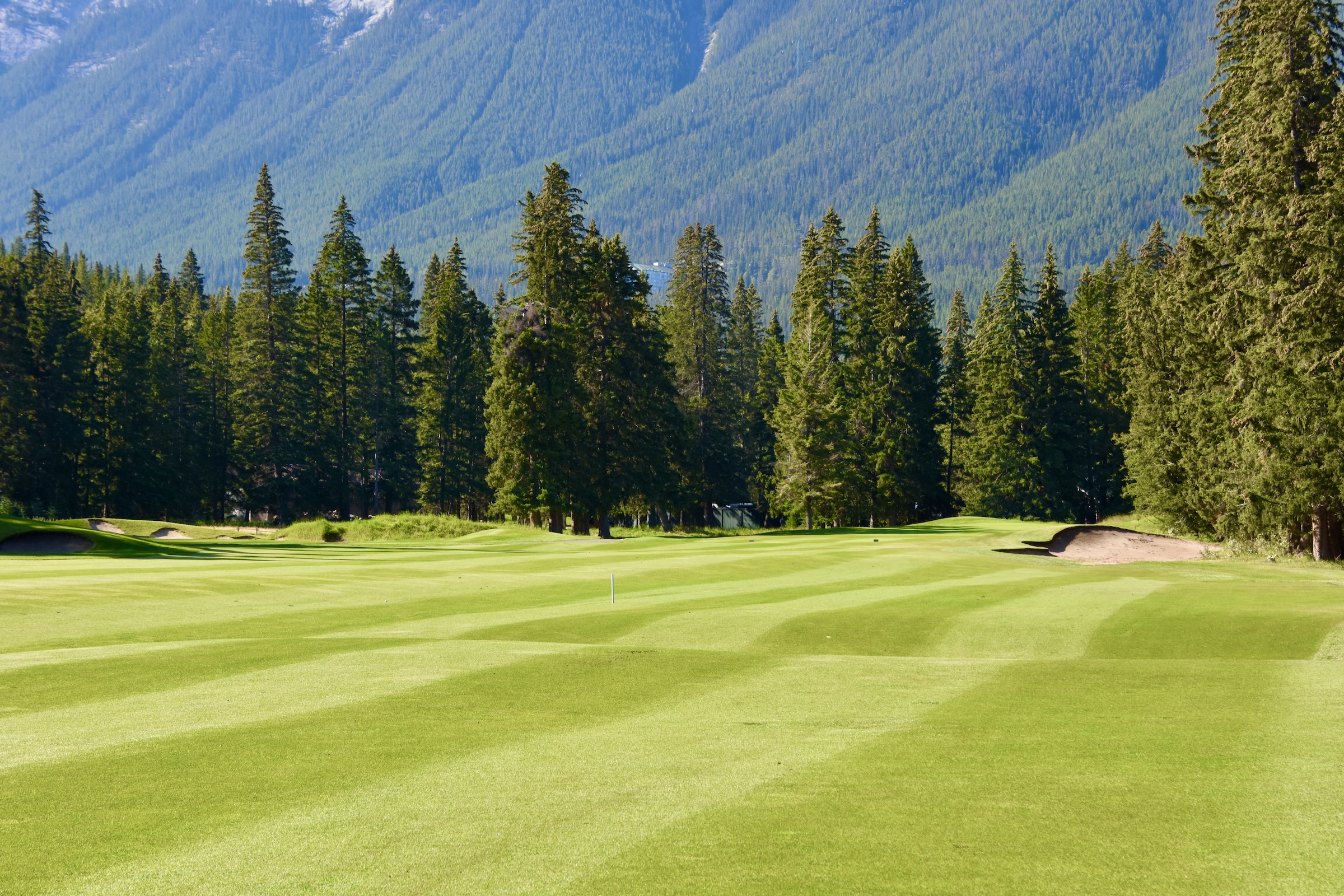
I didn’t really accomplish my goal off the tee and once again have a very ,long and difficult approach shot. I’m definitely going to take the trap out of play which means I’ll almost certainly come up short.
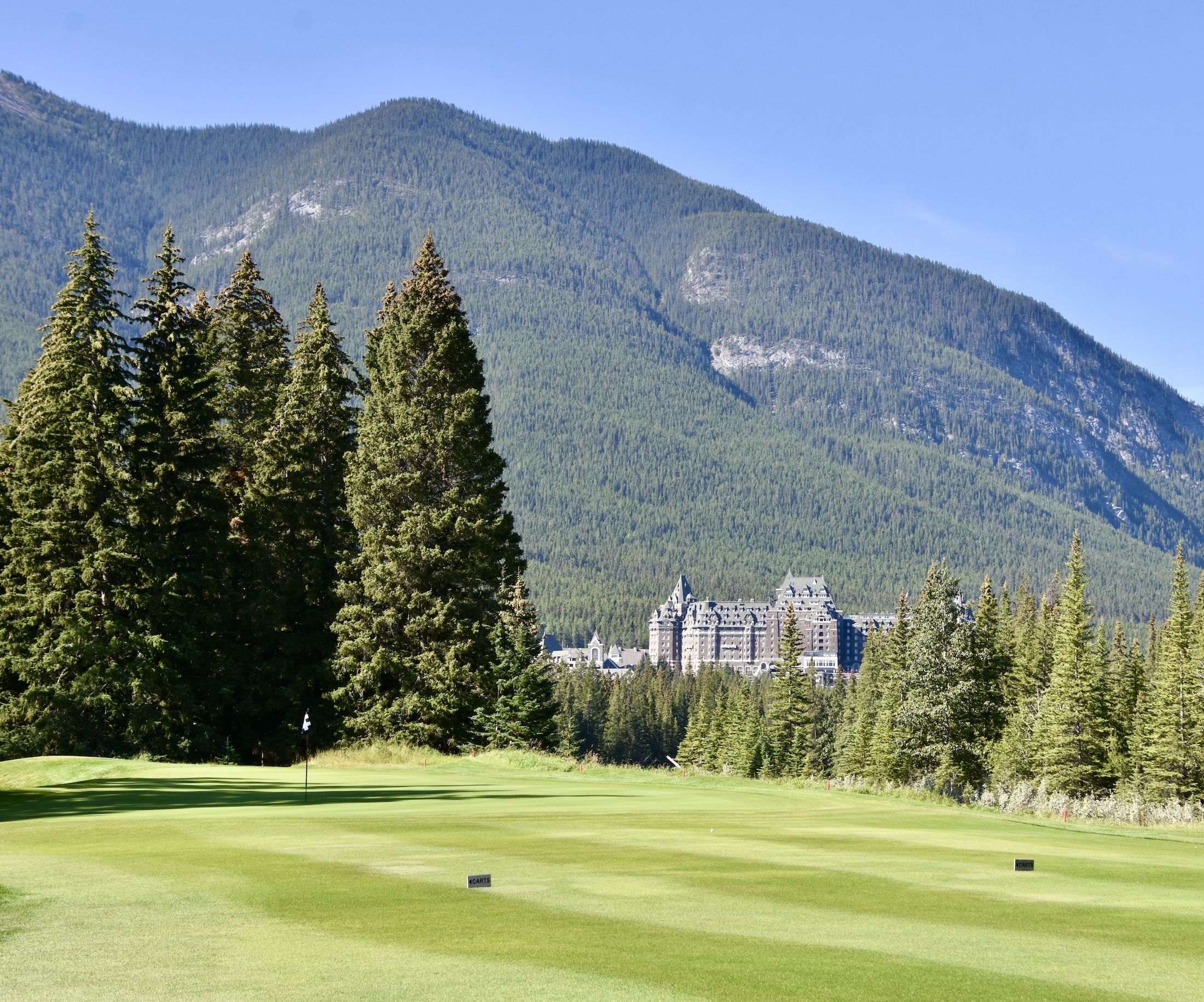
My prediction comes true and I’m well short, setting up another bogey, but my God, when you come up to this green and get your first view of the Banff Springs hotel on the opposite side of the Bow River, who cares? For my money there’s only one other hotel in Canada that comes remotely close to the grandeur of this location and that’s the Chateau Frontenac in Quebec City, which incidentally is also a Fairmont.
An added bonus on this hole aside from the view, is the presence of the Bow River literally just to the right of the green.
Banff Springs #13 Sulphur – 191 Yard Par Three
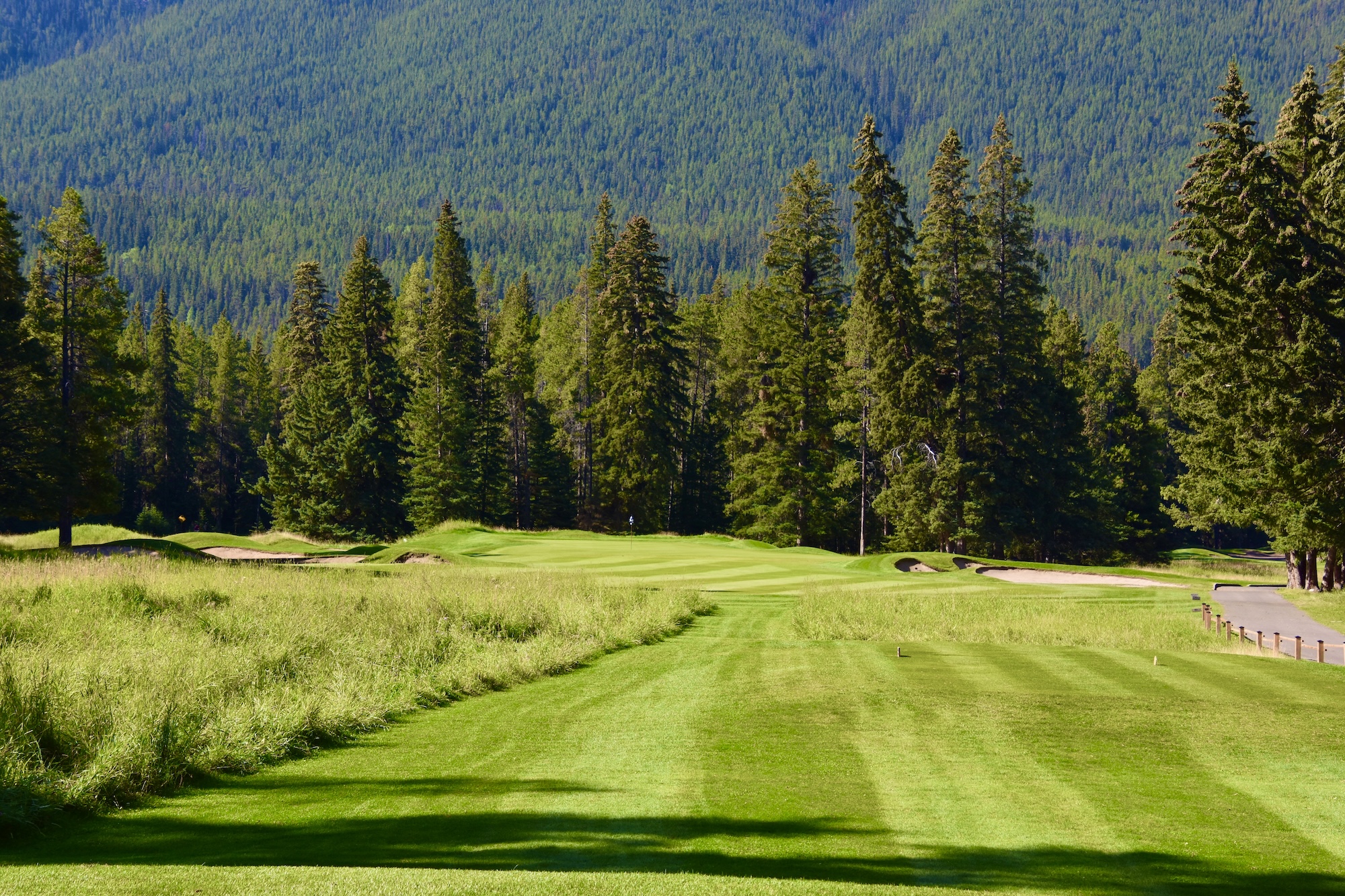
Although this photo doesn’t show it, this hole is named for Sulphur Mountain that looms in the background. Unlike #10, Stanley is not giving the oldsters a break on this par three. However, at 191 yards it is, for me, a well struck three wood. With no trouble straight ahead this hole does play easier than it looks from the tee.
#14 Wampum – 411` Yard Par Four
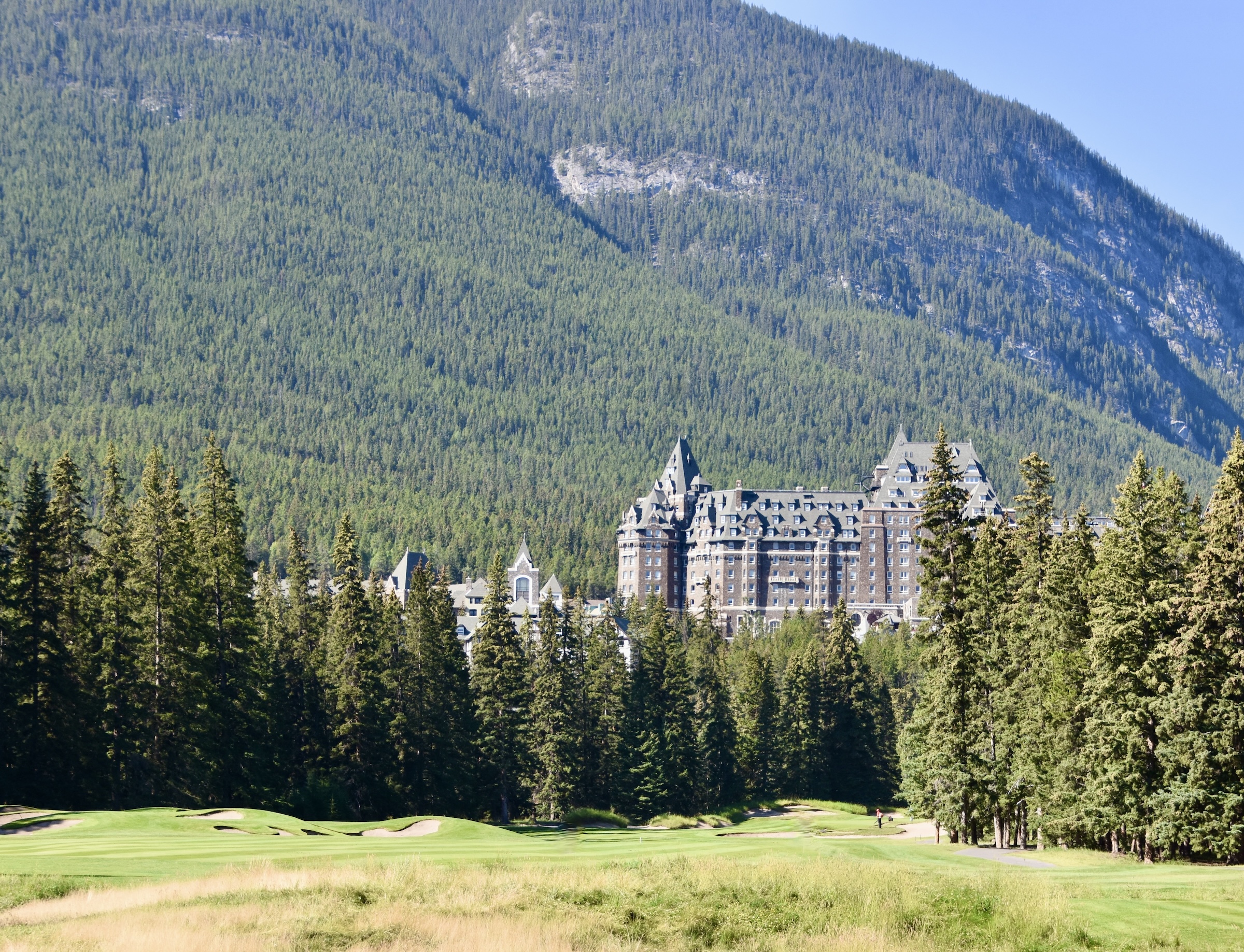
The third long par four in the last four holes is the #2 stroke hole at Banff Springs and from the tee it looks it. At 411 yards this will be a three shot hole for me so I put the driver away. The landing area between the traps and the woods on the right is very narrow so I opt for a five wood which I can control better than a three.
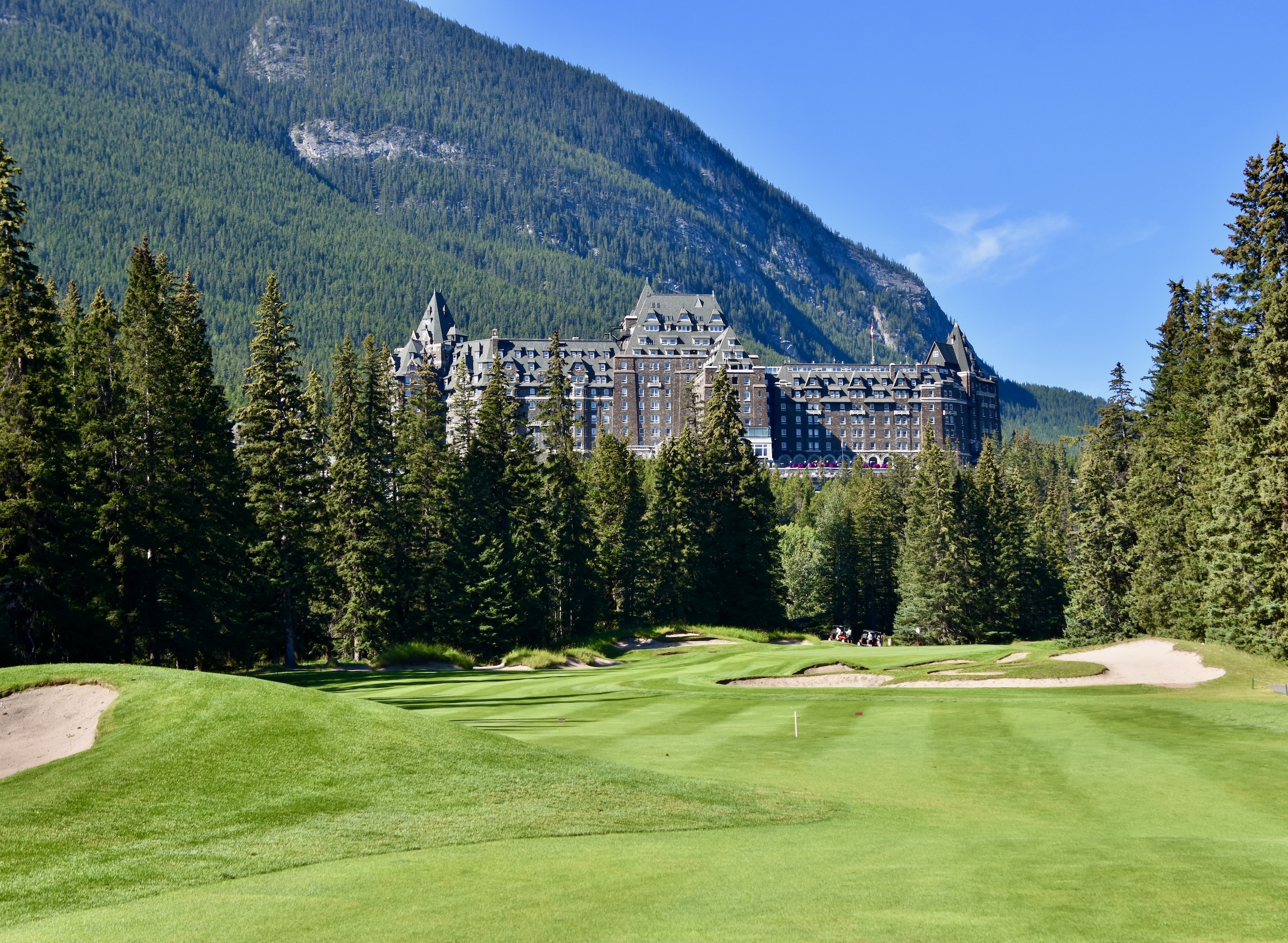
Another five wood will get me over the traps straight ahead leaving a wedge in for yet another bogey. Not a bad score on this hole. And there’s the added bonus of those mesmerizing views of the hotel.
Banff Springs #15 Spray – 405 Yard Par Four

We now come to one of Banff Springs most famous holes, the second after #4 to make it into the Top 1001 holes on earth. For the tee shot you need to clear the Spray River below. It looks daunting, but the carry is not as long as it looks and the fairway is wide enough that you can safely hit driver here. In fact you need the distance to have any chance of getting home in two. I’m really starting to realize just how tough this stretch on the back nine really is.
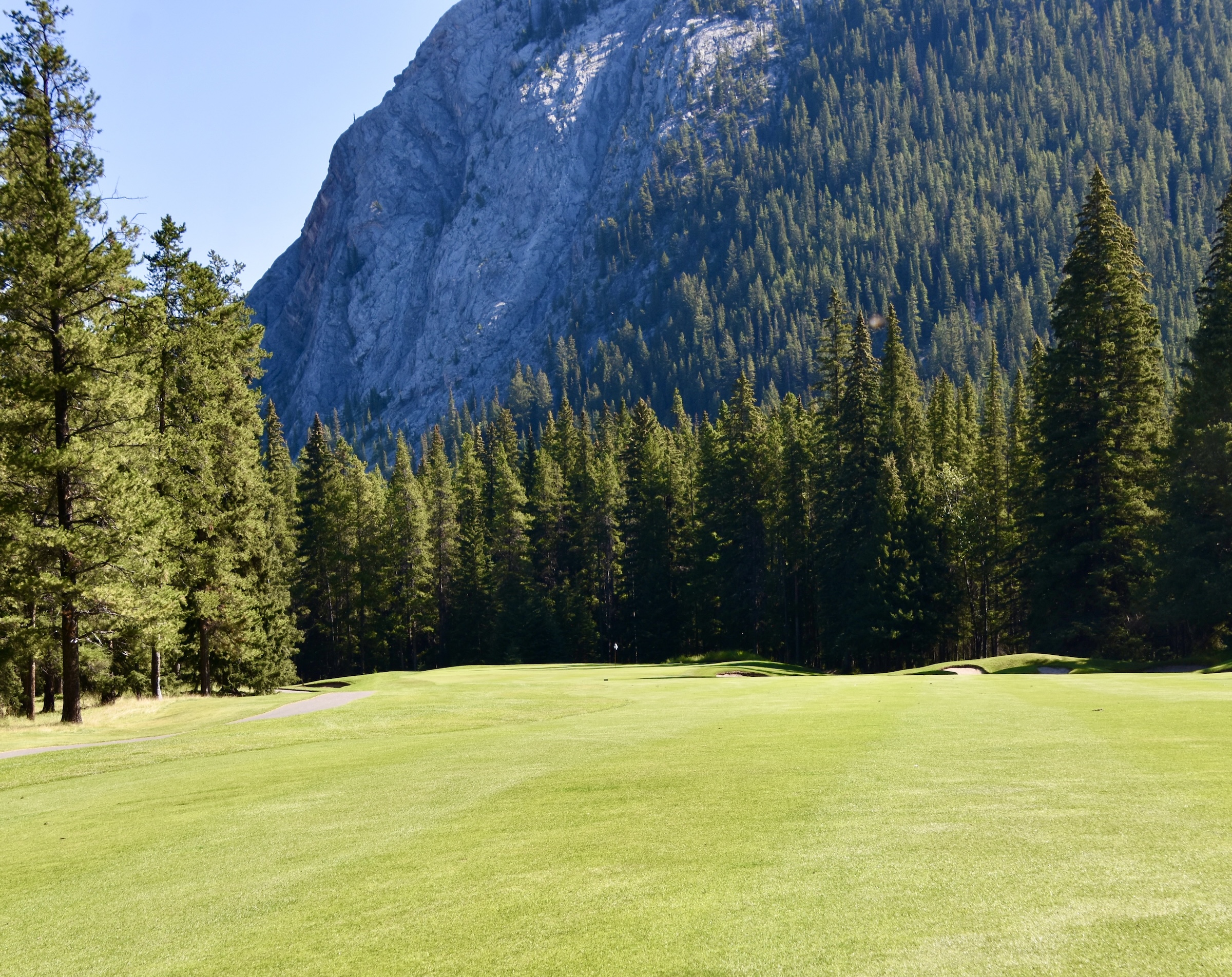
Due to the elevation drop Spray plays shorter than its stated yardage and for the first time on the back I do get home in two with my trusty five wood. It’s the first par in what seems like forever and there’s a real sense of accomplishment in doing so on this revered hole.
#16 Goat – 348 Yard Par Four

Finally, a par four that’s not a ball buster! The hole is named for the mountain goats that used to seen here in the early days, but have now moved to a different locale. But that does remind me that we have not seen any of the wildlife for which Banff Springs is justly famous for, especially the elk. I’ve seen their tracks in the traps and on the greens, but no sign of them in person.
The traps straight ahead are only an issue for those playing from the back tees and the way the hole flows I aim at the far trap and let the ball fade away from it.
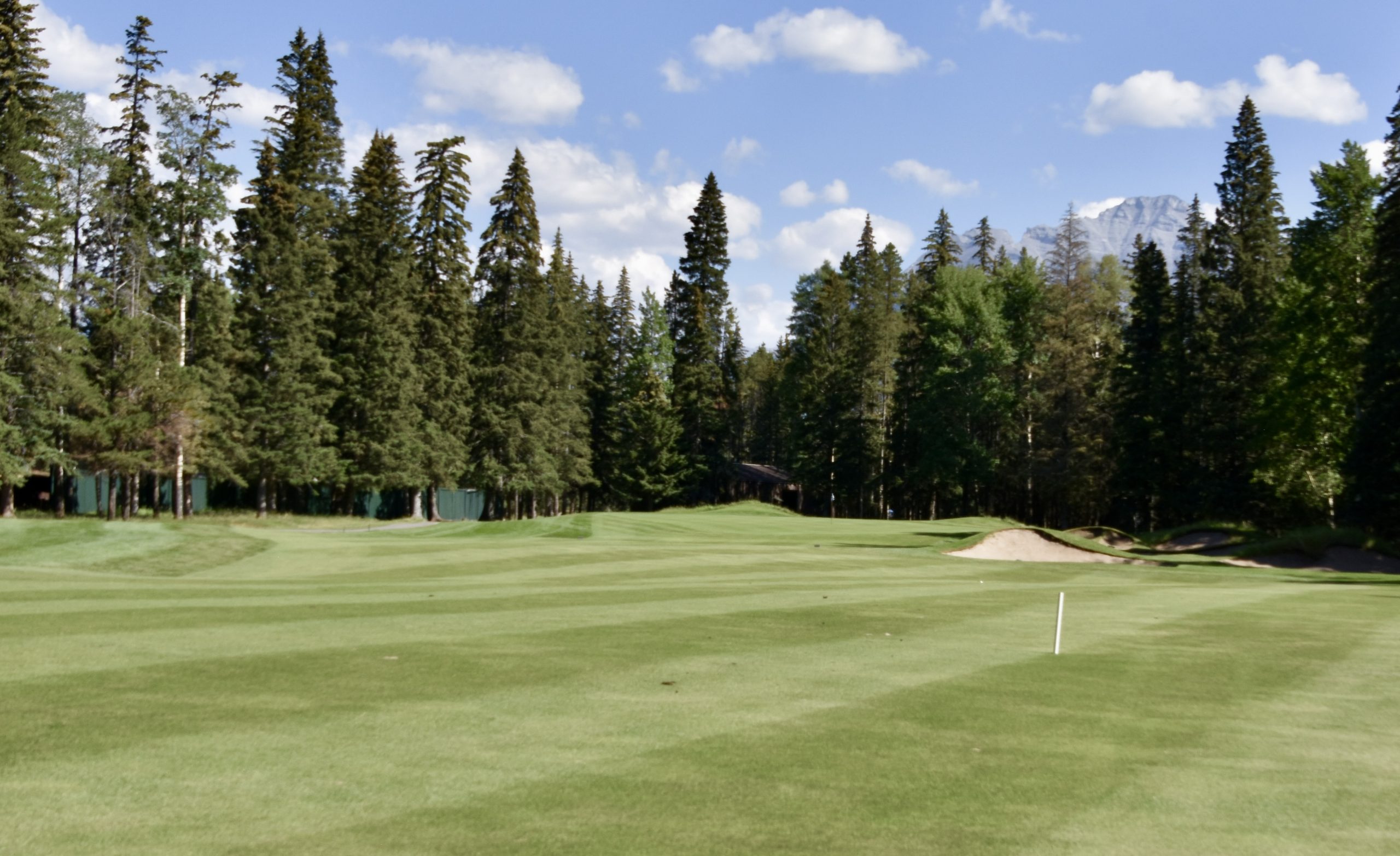
It certainly wasn’t my best drive distance wise, but I still have a pretty clear shot at the green and do manage a second par in a row.
Banff Springs #17 Sarcee – 337 Yard Par Four
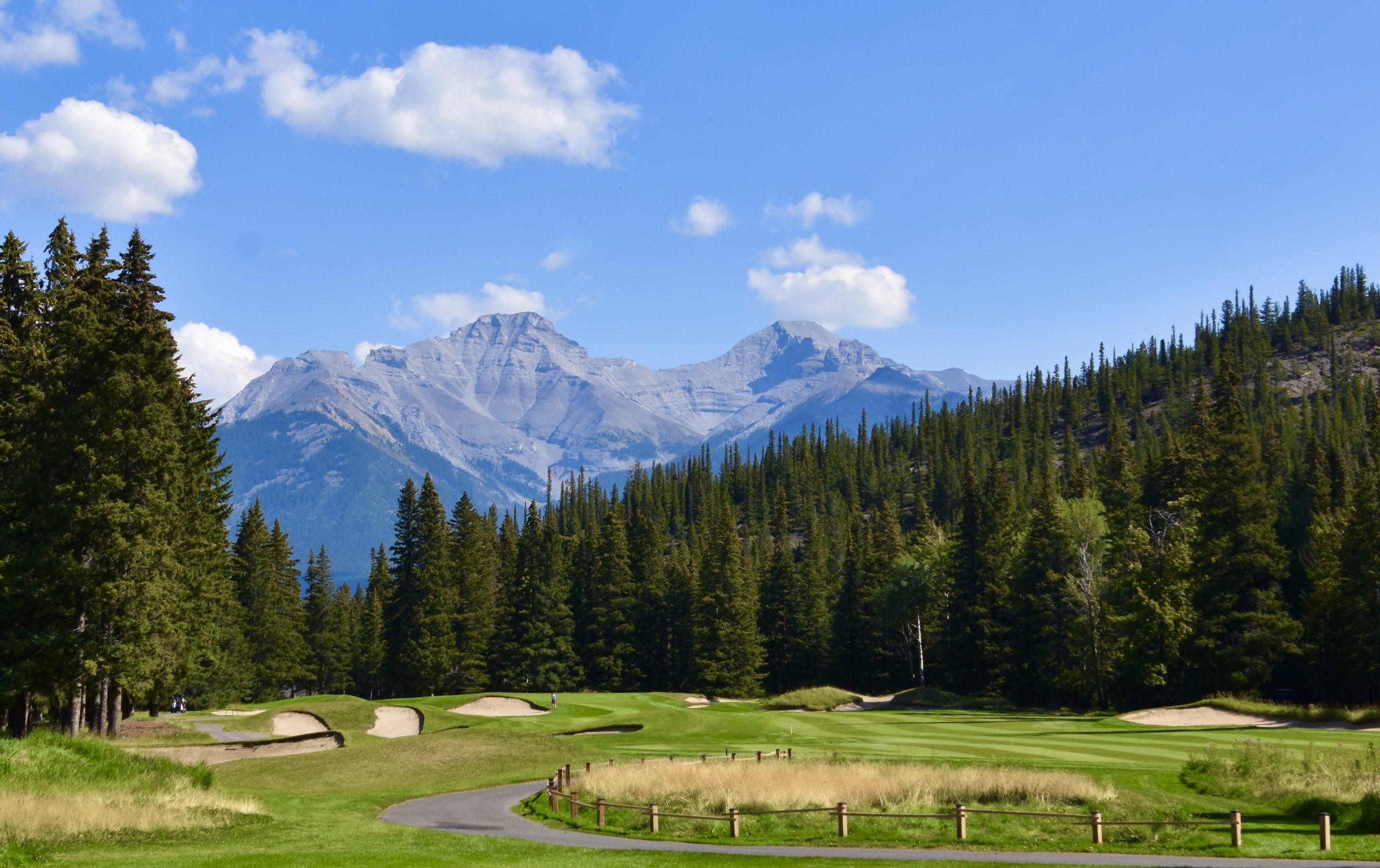
Another short, but treacherous looking par four. Oh, and amazingly beautiful as well! It is rated as the easiest hole at Banff, but it sure doesn’t look it from here. It does not require a driver, just use anything that will avoid the traps left, right and centre. Once again Mr. five wood is called upon.
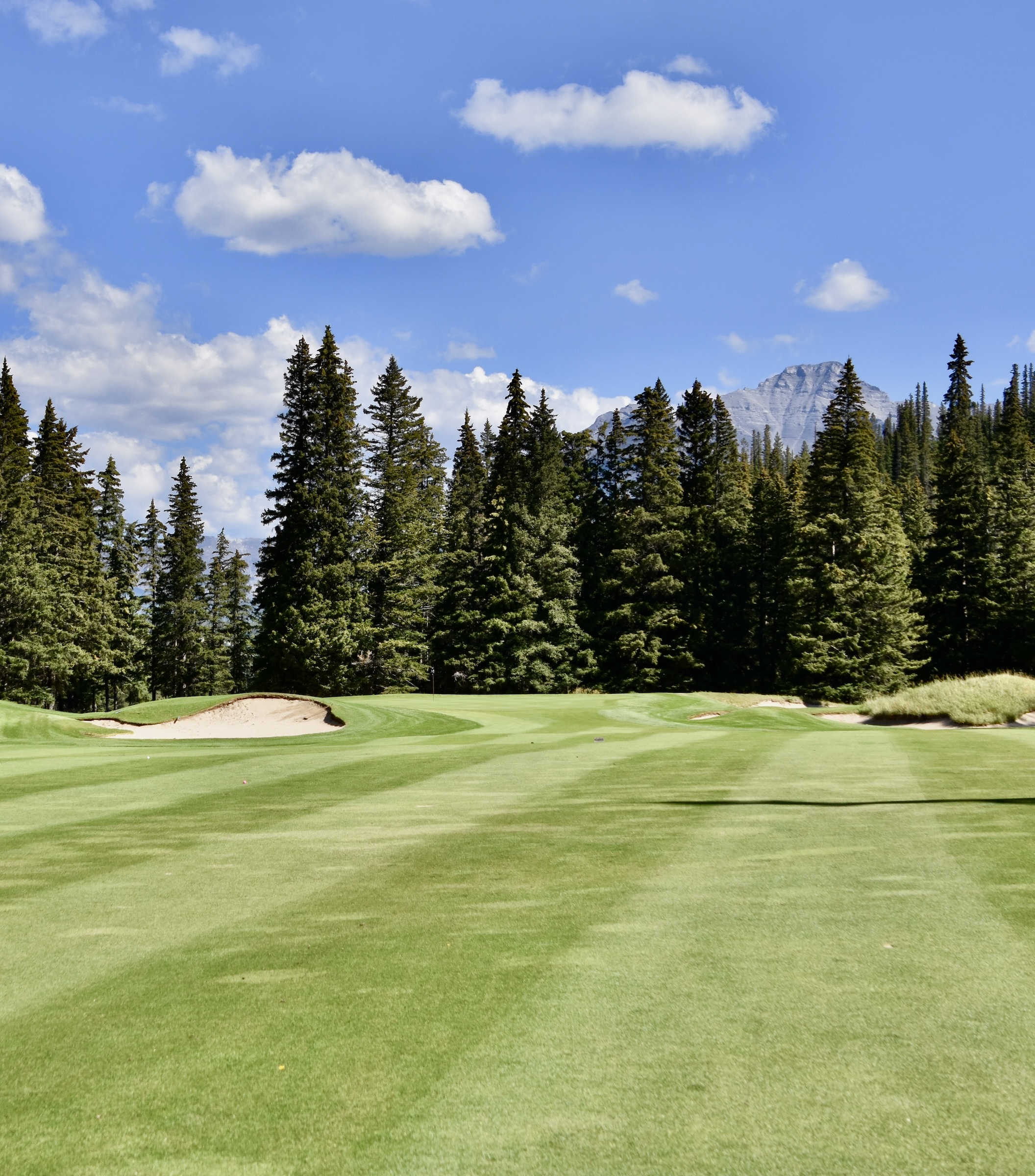
And he comes through leaving another quite doable approach shot. However, I get cocky and make my first three putt of the round. Glad I waited 17 holes to do it.
#18 Windy – 457 Yard Par Five

What a gorgeous looking finishing hole. At 457 yards I’m going to play it conservatively and hope to wipe the taste of the three putt from my mind. Three wood is the club here as I’m not even going to think about cutting the distance by challenging the trouble on the right.
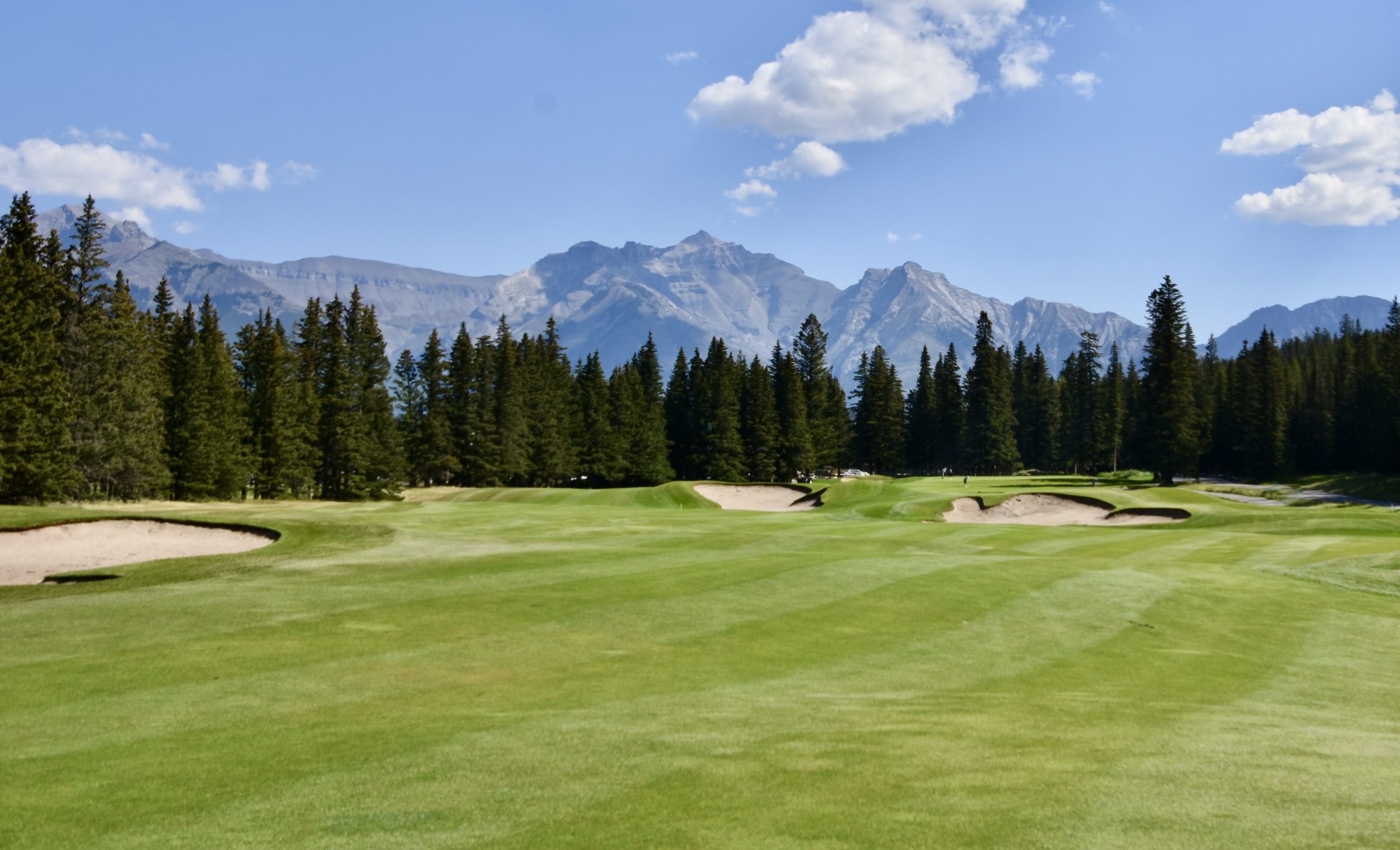
The three wood stayed short of the trap on the left leaving this look for the second shot. I can now go straight over the traps ahead with a 3 hybrid.
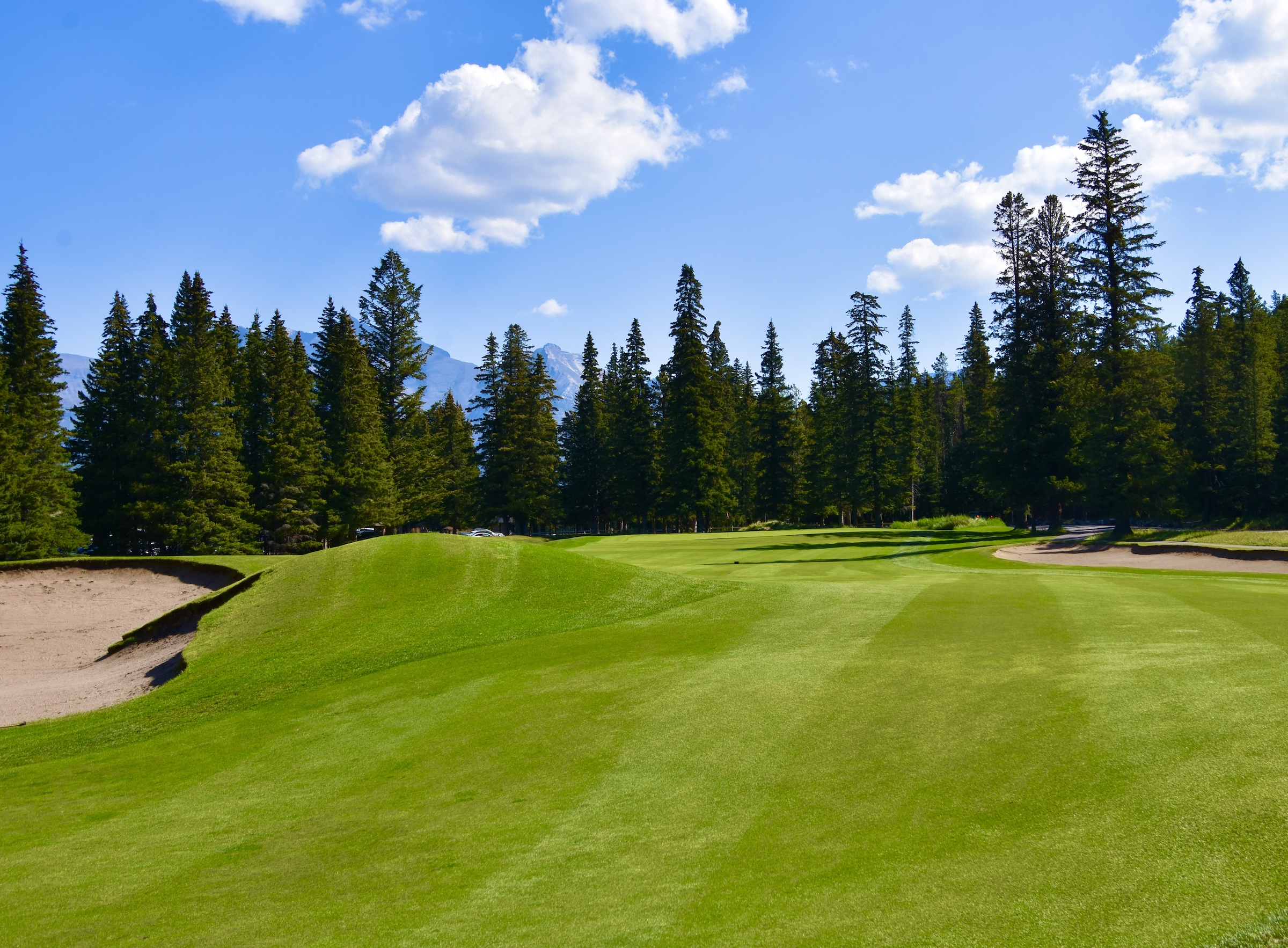
It’s farther than I would have liked, but it’s still just a wedge into a slightly elevated green and a final par.
Alison and I waited a long time to finally get to Banff Springs, but we both agreed it was one of the most enjoyable rounds we have ever played. This iconic course lives up to and even exceeds its vaunted reputation. Every Canadian golfer should bite the bullet and fork out for a round here, it is worth every penny.

